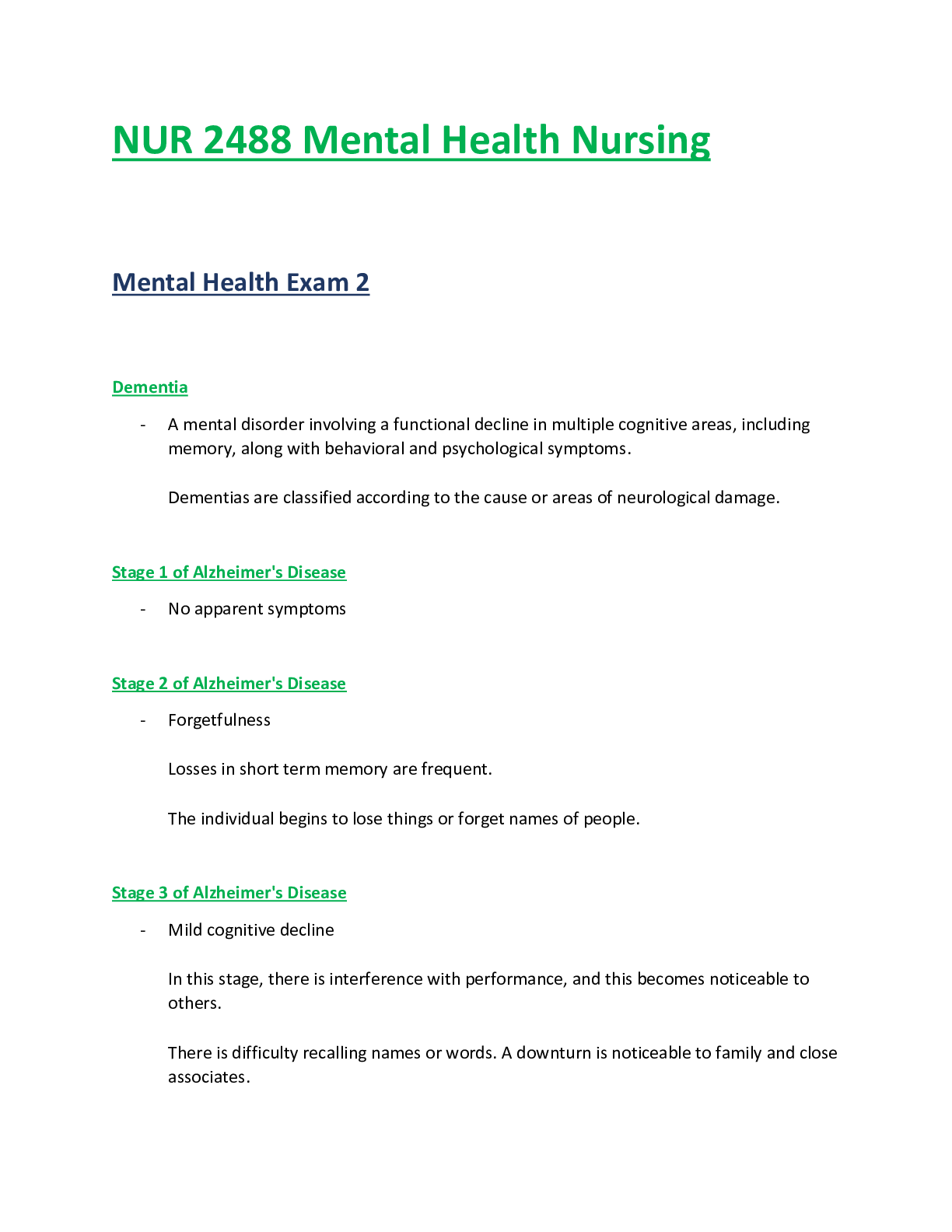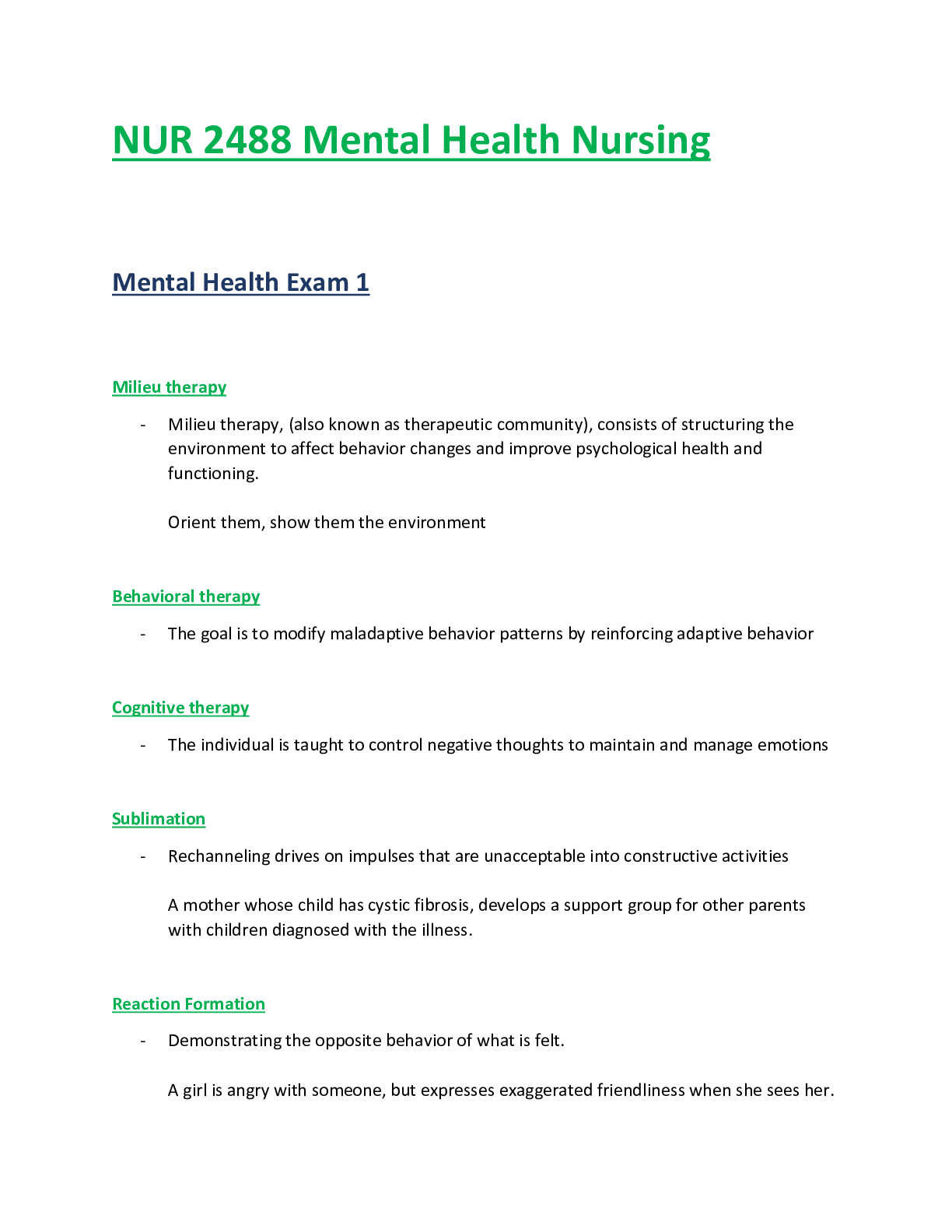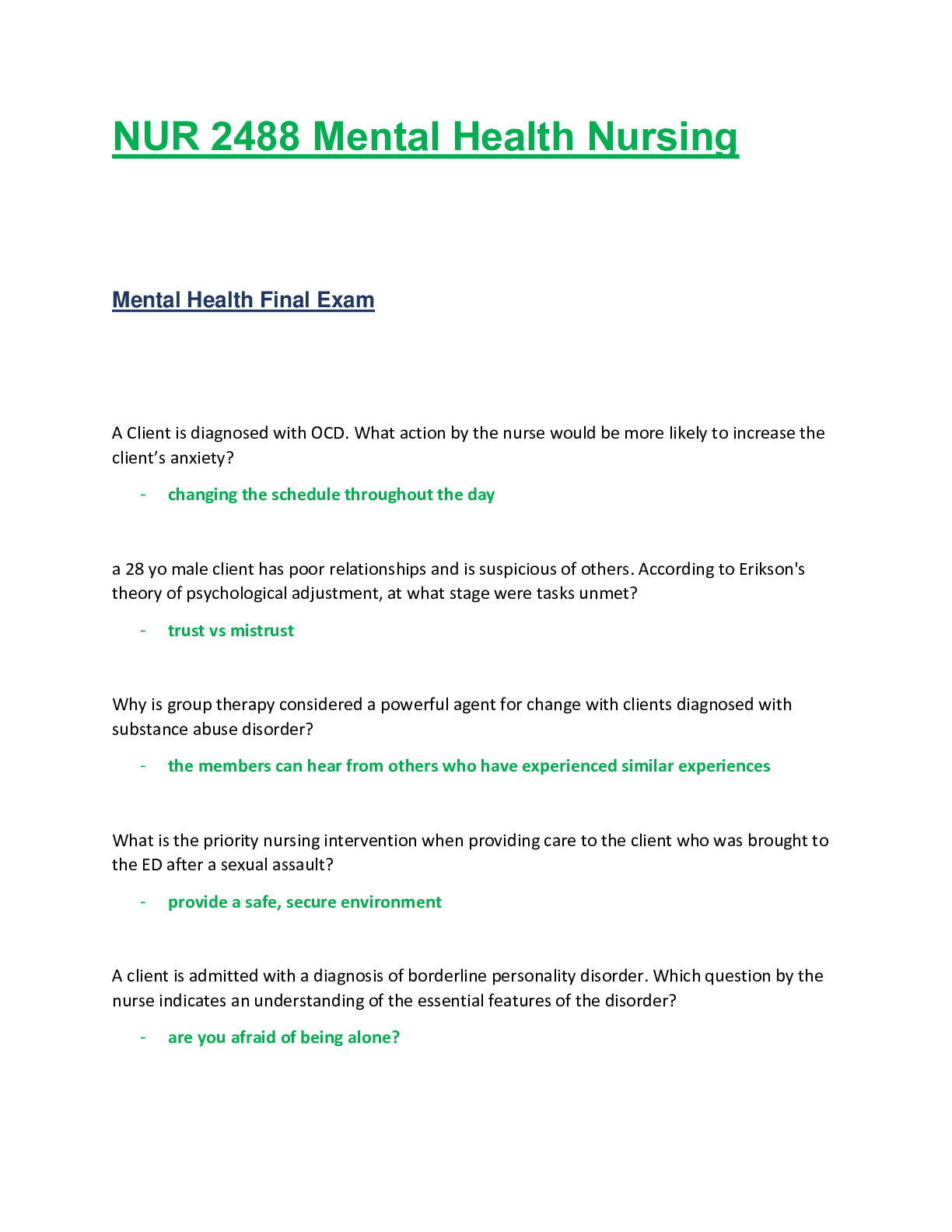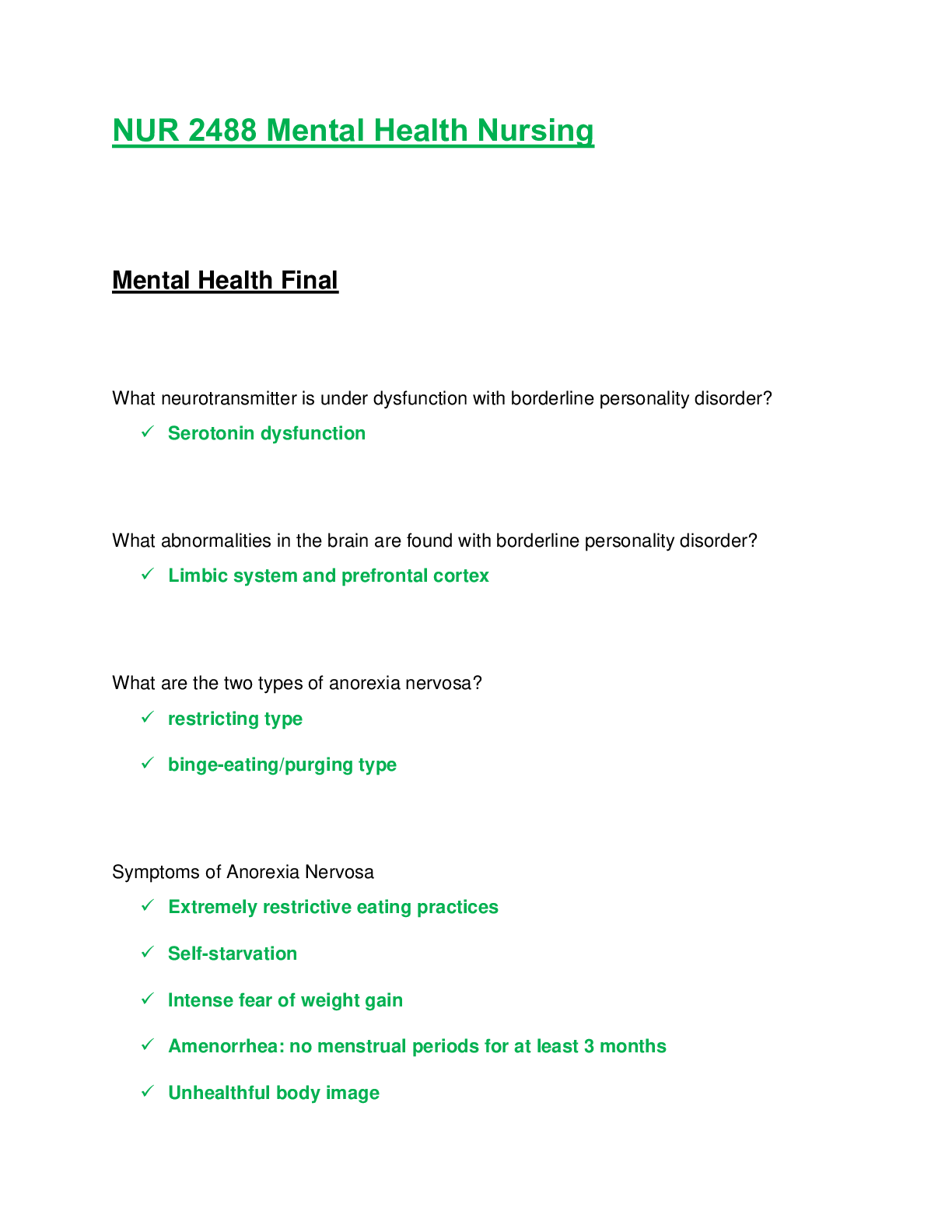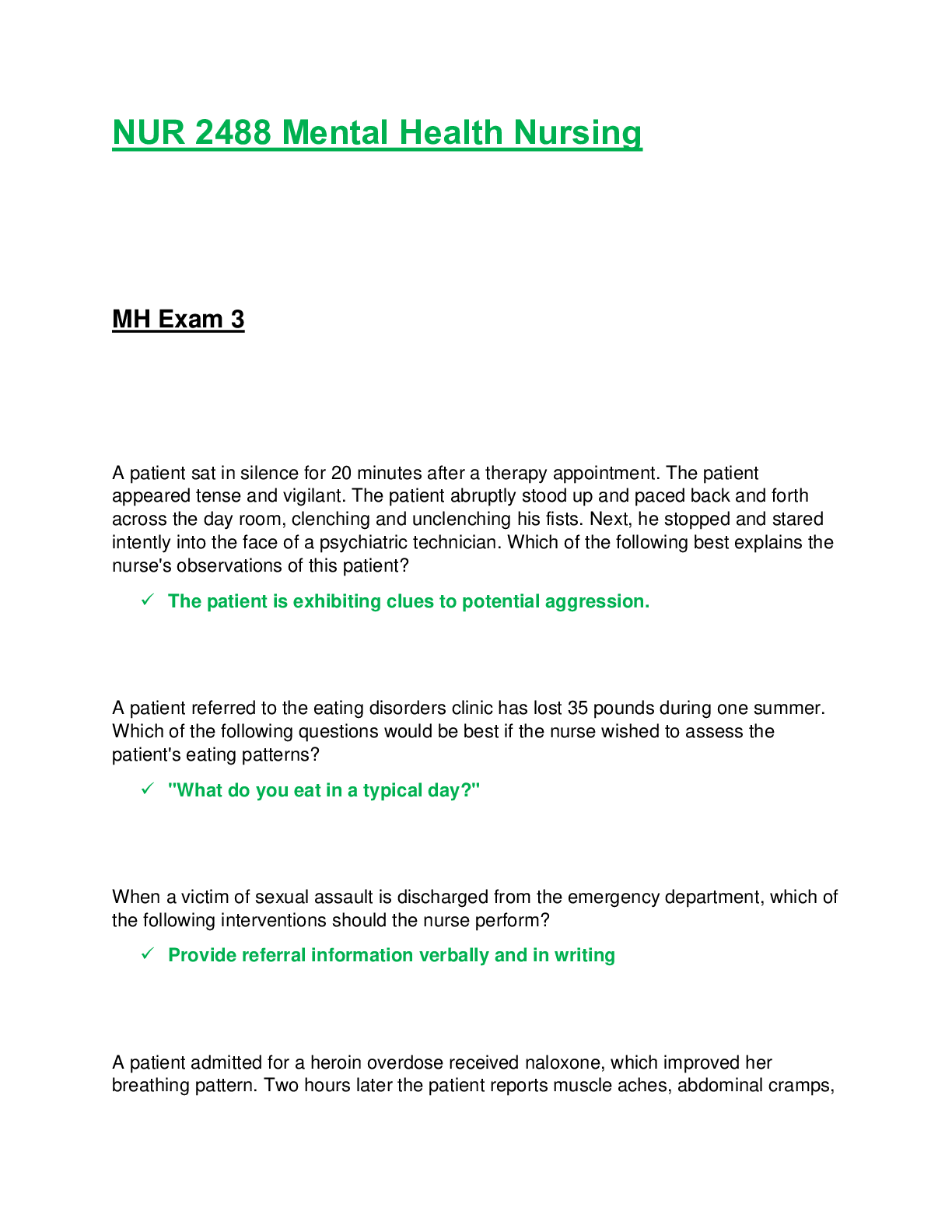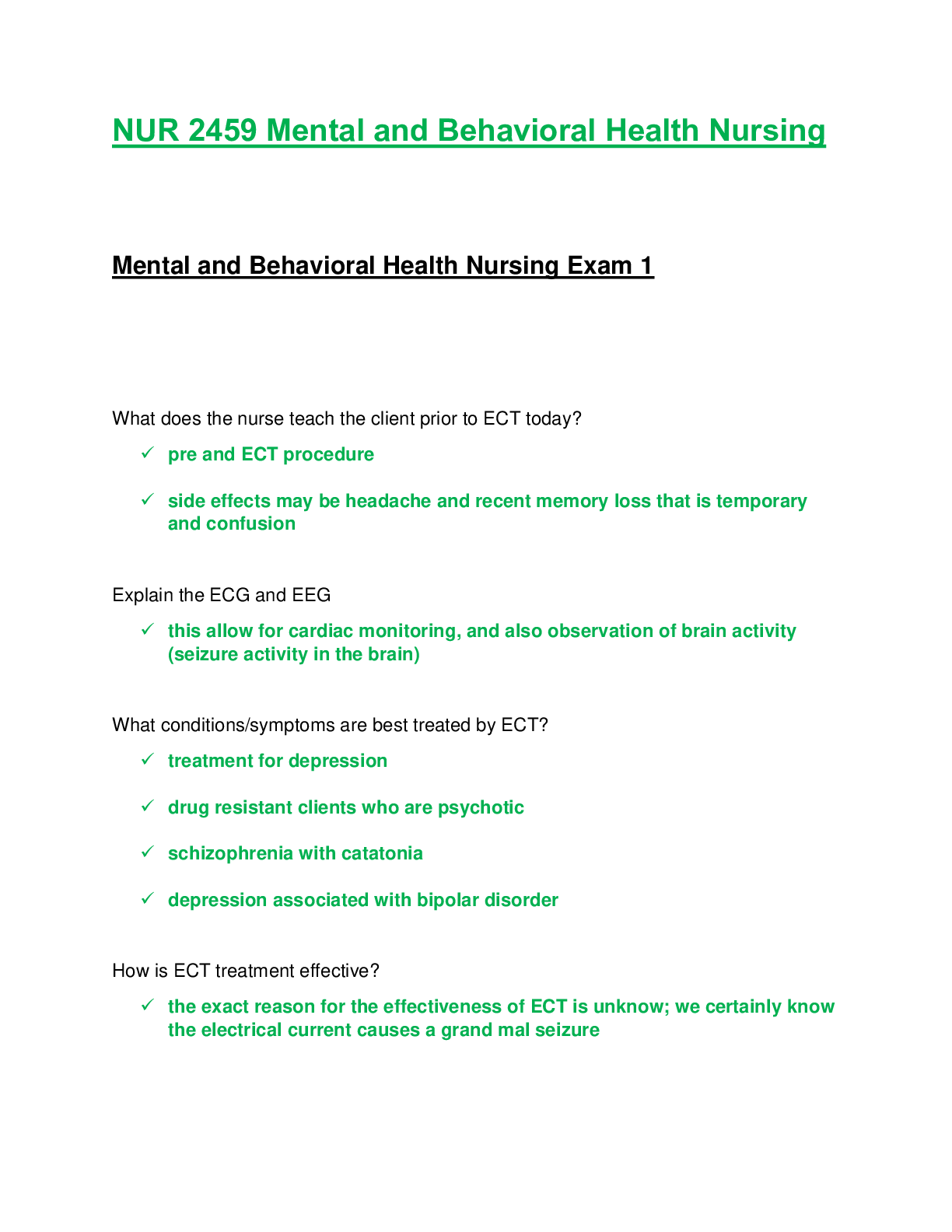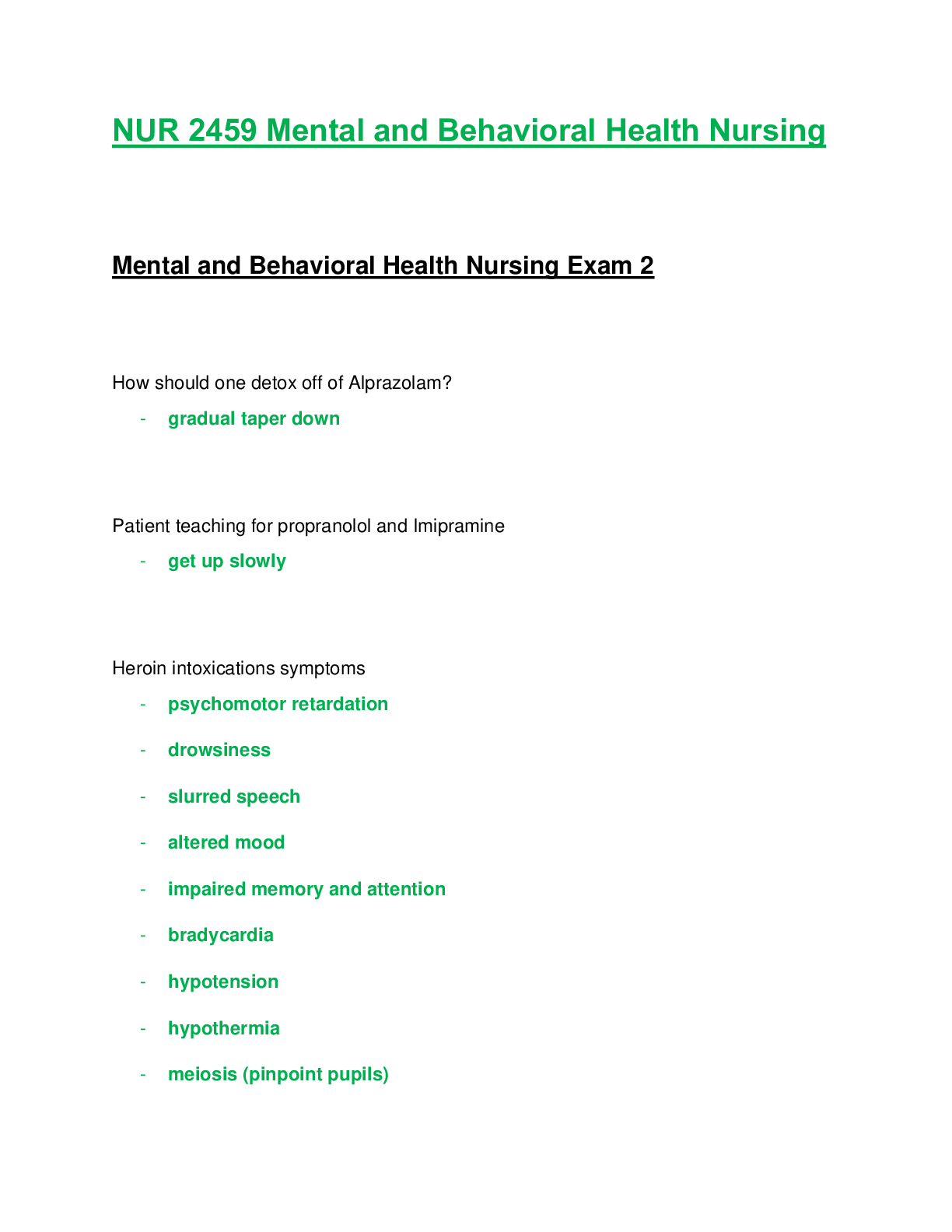NUR2488 / NUR 2488: Mental Health Nursing Exam 2 Latest Update Rasmussen
Document Content and Description Below
NUR 2488 Mental Health Nursing MH Exam 2 1. Which documentation indicates that the treatment plan for a patient with acute mania has been effective? a) "Converses without interrupting,... clothing matched, participates in activities." b) "Irritable, suggestible, distractible, napped for 10 minutes in afternoon." c) "Attention span short, writing copious notes, intrudes in conversations." d) "Heavy makeup, seductive toward staff, pressured speech." 2. nurse is assessing for EPS s/e in a pt who has been taking chlorpromazine. Which may be side effects for this med? (SATA) a) Akathisia b) Acute dystonia c) Tardive Dyskinesia d) Amenorrhea 3. An adult with depression has been tx with medication and cognitive behavioral therapy. The patient now verbalizes that being passive and letting others make decisions for her contributed to the depression. What referrals could the nurse make to help this patient prevent recurrence of depression? a) Social skills training b) Use of complementary therapy c) Relaxation training classes d) Learning desensitization techniques 4. A patient with suicidal impulses is placed on the highest level of suicide precautions. Which measures should be incorporated into the plan of care by the nurse caring for the patient? (Select all that apply.) a) Maintain arm's-length distance, institute one-on-one nursing observation around the clock b) Allow no glass or metal on meal trays c) Keep patient within visual range while awake, but only check every 15 to 30 minutes while the patient is sleeping d) Only check the patient's whereabouts every 15 minutes and make frequent verbal contacts. e) Remove all potentially harmful objects from the patient's possession 5. Which statement indicates a patient with major depression's most likely outlook on life during the acute phase of the illness? a) "It's just a matter of time and I'll be well." b) "I deserve to be this way." c) "I can fight this and get better." d) "If I ignore this, it will go away." 6. The nurse knows that sedation is a side effect of many antipsychotics. Which of the following medications should the nurse question if ordered for a patient taking antipsychotics? a) hydrochlorothiazide b) diphenhydramine c) acetaminophen d) verapamil 7. The nurse is caring for a patient who experiences orthostatic hypotension related to taking chlorpromazine. The nurse should suggest which of the following interventions for managing this side effect? a) Stay in bed for an hour after taking the medication. b) Sit on the side of the bed before standing up. c) Stand quickly, then wait a moment before walking. d) Take the medication with milk or food. 8. The nurse is evaluating the effectiveness of an antipsychotic on negative symptoms of psychosis. Which of the following symptoms would be classified as negative symptoms of psychosis? a) illogical speech b) bizarre behavior c) delusions d) flat affect 9. During the maintenance phase of treatment, a patient with bipolar disorder asks the nurse, "Do I have to keep taking this lithium even though my mood is stable now?" Which is the most appropriate response? a) "You will be able to stop the medication in about 1 month." b) "Usually patients take medication for approximately 6 months after discharge." c) "Taking the medication every day helps prevent relapses and recurrences." d) "It's unusual that the health care provider hasn't already stopped your medication." 10. A patient with bipolar disorder commands another patient to "Get me that book. Take this other stuff out of here," and makes other similar demands. Which of the following actions could the nurse use to interrupt this behavior without entering into a power struggle with the patient? Select all that Apply a) Provide advice on how to correct behavior b) Using humor c) Providing a distraction d) Setting clear limits e) Provide advice on how to correct behavior 11. A patient with depression is evaluated at the clinic and started on citalopram. The patient tells the nurse, "I have some pills I previously took for depression. They're called MAOIs. I think I should take them along with this new medication." What information is essential for the nurse to communicate regarding her statements? a) The need to have blood pressure carefully monitored b) That SSRI antidepressant will be more effective in 3 weeks. c) The dietary restrictions required when taking MAOIs. d) The risk of a serious reaction if SSRIs and MAOIs are combined. 12. A patient with schizophrenia begins to talks about "volmers" hiding in the warehouse at work. Which of the following should the term "volmers" be assessed as? a) A neologism b) Concrete thinking c) Thought insertion d) An idea of reference 13. The nurse is caring for a female patient diagnosed with schizophrenia who believes that her thoughts are broadcast to others. What is the most appropriate nursing diagnosis for this patient? a) Risk for Self-Directed Violence b) Impaired Communication c) Disturbed Thought Processes d) Disturbed Sensory Perception 14. A nurse receives this laboratory result: lithium level 1.7 mEq/L. How should the nurse interpret this lab value? a) Within therapeutic limits b) Below therapeutic limits c) Above therapeutic limits d) Incorrect because of inaccurate testing 15. Which of the following interventions should the nurse prioritize for a patient with severe depression? a) Allowing the patient to spend long periods alone in meditation. b) Careful unobtrusive observation around the clock c) Encouraging the patient to spend a major portion of each day in bed 16. Which comment by a patient experiencing severe anxiety would indicate the possibility of obsessive-compulsive disorder? a) "I have to keep checking to see where my car keys are." b) "My legs feel weak most of the time." c) "I'm afraid to go out in public." d) "I keep reliving the car accident." 17. When educating a client and their family about taking a serotonin reuptake inhibitor (SSRI), which should the nurse prioritize for teaching purposes? a) Avoid exposure to bright sunlight b) Report increased suicidal thoughts c) Restrict sodium intake to 1 g. daily d) Maintain a tyramine free diet 18. Which of the following are potential complications that the patient receiving lithium should be assessed for? a) Hair loss, rash, and drowsiness b) Sore throat, dry eyes, and dystonia c) Diaphoresis, weakness, and nausea d) Abdominal distention, dyspnea, and edema 19. Which statement by a patient in the continuation phase of treatment for bipolar disorder indicates that a referral may still be needed? a) "It is difficult to live down all the crazy stuff I did during my last manic episode." b) "I am getting better at problem solving thanks to the group I attend every Wednesday." c) "Using a financial counselor to help manage my money is keeping me out of debt." d) "I used to drink a lot, but Alcoholics Anonymous helps me manage stress without drinking." 20. Which nursing diagnosis is likely to apply to an individual with a severe and persistent mental illness who is homeless? a) Substance abuse b) Chronic low self-esteem c) Insomnia d) Schizophrenia 21. A patient is undergoing a series of diagnostic tests. The patient says, "Nothing is wrong with me except a stubborn chest cold." The spouse reports the patient smokes and coughs a lot, has lost 15 pounds, and is easily fatigued. Which defense mechanism is the patient using? a) Regression b) Displacement c) Denial d) Projection 22. A patient with generalized anxiety disorder comes to the clinic with severe anxiety. Of these medications in the patient's medical record, which is most appropriate to give as an as needed (prn) anxiolytic medication? a) Buspirone b) Lorazepam c) Phenytoin d) Fluoxetine 23. When assessing a patient's plan for suicide, what aspect has priority? a) Patient's financial and educational status b) Patient's insight into suicidal motivation c) Availability of means and lethality of method d) Quality and availability of patient social support 24. A veteran of the Iraq War describes that he is having intrusive thoughts of missiles, screaming, explosions, and the same feelings of terror first experienced in combat. Which of the following clinical disorders would this patient most likely be describing symptoms of? a) obsessive-compulsive disorder. b) generalized anxiety disorder. c) panic disorder with agoraphobia d) posttraumatic stress disorder. 25. A patient with catatonic schizophrenia exhibits little spontaneous movement and demonstrates waxy flexibility. According to Maslow's hierarchy of needs, which needs are of priority importance for this patient? a) Physical b) Psychosocial c) Safety and security d) Self-actualization 26. An adult says, "When I was a child, I took medication because I couldn't follow my teachers' directions. I stopped taking it when I was about 13. I didn't make good grades in high school and barely graduated. I still have trouble getting organized, which causes difficulty doing my job." Which clinical disorder does this scenario suggest? a) Stress intolerance disorder b) Generalized anxiety disorder c) Paranoid Schizophrenia d) Adult attention deficit hyperactivity disorder 27. A nurse works a telephone suicide crisis line. A caller says, "I live alone in a home several miles from my nearest neighbors. I've been considering suicide for 2 months. I've had several drinks and now my shotgun is loaded. I'm going to shoot myself in the heart." How would the nurse assess the lethality of this plan? a) No risk b) Low level c) Moderate level d) High level 28. A 39-year-old woman is recently divorced and is learning to cope with additional stressors. Which of the following best demonstrate(s) that she is utilizing positive coping strategies to manage her stress? (Select all that apply). a) Starting an exercise program b) Going to the bar to drink beer after work c) Using cognitive behavioral therapy techniques d) Increasing her hours at work to avoid being alone at home 29. A patient with acute mania approaches the nurse, waves a newspaper, and says, "I must make a phone call right this minute. I need to call a store while their sale is going on. I need to order 10 dresses and four pairs of shoes." Which of the following would be the most appropriate intervention for the nurse to implement? a) Tell the patient phone use is not allowed until self-control is improved b) Suggest the patient have a friend do the shopping and bring purchases to the unit. c) Assist the patient to make the purchases. d) Invite the patient to sit with the nurse and look at new fashion magazines as a distraction. 30. Which of the following is a therapeutic communication strategy to use when working with a client who has auditory hallucinations? a) Pretending that you know what the patient means when he says "they" b) Asking the client to describe his hallucination. c) Responding to the client's hallucinations as if they are real. d) Limiting contact with the client to 1-2 short interactions per day 31. A patient was admitted to the inpatient psychiatric unit with a diagnosis of PTSD and a history of violence. While on the unit, he has been having trouble sleeping and reports flashbacks. He has also reported feeling anger toward another patient who looks and acts like his former employer. The priority nursing diagnosis would be: a) Night Terrors b) Ineffective Individual Coping c) Risk for Other-Directed Violence d) Anxiety r/t Traumatic War Experience 32. Your patient is very stressed about work, and has started taking yoga classes. Which comment would indicate that this physical activity has been successful? a) "My doctor said my blood pressure has gone down" b) "I have a lot less energy than I used to have." c) "My muscles are kind of tight." d) "I noticed my resting pulse rate has gone up." 33. If a cruel and abusive person rationalizes the behavior, which comment would be most characteristic of rationalization as a defense mechanism? a) "I don't know why it happens." b) "That person shouldn't have provoked me." c) "I'm really a coward who is afraid of being hurt." d) "I have poor impulse control." 34. A nurse encourages a moderately anxious patient to talk about feelings and concerns. What is/are the rationale(s) for this intervention? (Select all that apply). a) Offering hope always defuses the patient's anxiety b) Concerns stated aloud become less overwhelming and help problem solving begin c) Anxiety can be reduced by focusing on and validating what is occurring in the environment. d) Encouraging patients to explore alternatives increases the sense of control and lessens anxiety. 35. A nurse is teaching a patient with paranoid schizophrenia and her family regarding medication management. The patient states "I don't like taking pills," and the family confirms that they are worried about compliance. Which treatment strategy should the nurse discuss with the health care provider? a) Use of a long-acting injectable form of medication b) Adding an antidepressant c) Adding a benzodiazepine to reduce anxiety about taking medication d) Prolonged hospitalization to ensure medication compliance 36. The nurse is providing health teaching for a patient who has been prescribed phenelzine for depression and provides a written list of foods that should not be eaten while taking this medication. What is the potential problem if the patient is not compliant with these dietary restrictions? a) the foods may cause decreased respirations and possible coma b) the patient may develop severe gastrointestinal distress c) the patient will have a sub-therapeutic level of the medication d) the foods may precipitate a life-threatening hypertensive crisis 37. Which beverage should be offered to a patient with depression who has been refusing to eat solid foods because it provides the most nutrients? a) Grapefruit Juice b) Orange Juice c) Hot tea d) Milk 38. At a unit meeting, staff discusses decor for a special bedroom for manic patients. Which is the best suggestion related to caring for an acutely manic patient? a) An extra-large window with a view of the street b) Brightly colored walls and print drapes c) Neutral colors for walls and upholstery d) Deep colors for walls with lavish, trendy accessories 39. Which statement by a patient with agoraphobia identifies the thinking typical of a patient with this disorder? a) "I'm sure I'll get over not wanting to leave home soon. It takes time." b) "When I have a good incentive to go out, I'm confident I can do it." c) "My family tells me they like it now that I stay home." d) "Being afraid to go out seems ridiculous, but I can't go out the door." 40. A patient with depression is receiving imipramine 200 mg every day at bedtime. Which assessment finding would require the nurse to promptly collaborate with the health care provider regarding side effects of this drug? a) Dry mouth b) Blurred vision c) Nasal congestion d) Urinary retention 41. A salesperson has had difficulty keeping a job because of arguing with co-workers and accusing them of conspiracy. Today the salesperson was hospitalized after threatening a co-worker. When greeted by the nurse, the person shouts, "They're all plotting to destroy me. Isn't that true?" Select the nurse's most therapeutic response. a) "No that is not true. People here are trying to help you if you will let them." b) "Everyone here is trying to help you. No one wants to harm you." c) "Thinking that people want to destroy you must be very frightening." d) "That is absurd. Staff members are health care workers, not members of the mob." 42. A patient says to the nurse, "My life doesn't have any happiness in it anymore. I once enjoyed going out with friends, but now I don't care if they even invite me." Which term best describes this patient's feelings? a) Dysthymia b) Anhedonia c) Euphoria d) Anergia 43. A nurse implements medication education for a patient who takes phenelzine for depression. Which behavior indicates that the patient has effectively implemented the information provided? a) The patient monitors sodium intake and his weight daily. b) The patient wears support stockings and elevates the legs when sitting c) The patient can identify foods with high selenium content that should be avoided. d) The patient checks with the pharmacist or his physician before selecting over-the-counter medications. 44. A nurse is providing medication teaching for a client who has a new prescription for clozapine. Which of the following statements indicates a need for further teaching? a) "I should ask my doctor before taking a new vitamin or herbal supplement." b) "I will report flu symptoms immediately to my doctor." c) "I should keep my medication in a dry place at room temperature." d) "This medication will help prevent seizures." 45. The nurse is caring for a patient who takes antipsychotic medications and has developed muscle rigidity, hyperpyrexia, diaphoresis, and drooling. Which of the following adverse effects of antipsychotic medications is most likely causing these symptoms? a) Serotonin syndrome b) Tardive dyskinesia c) Pseudo-parkinsonism d) Neuroleptic malignant syndrome 46. A cab driver, stuck in traffic, suddenly becomes lightheaded, tremulous, diaphoretic, tachycardic and dyspneic. While being evaluated in the emergency department, the nurse recognizes the signs of severe anxiety. Which of the following would be included as nursing interventions? (Select All that Apply) a) Maintain a calm manner b) Demand the client answer questions c) Remain with the client d) Use clear and simple statements e) Speak loudly for client to hear 47. A patient tells the nurse, "I wanted my health care provider to prescribe diazepam for my anxiety disorder but buspirone was prescribed instead. Why is this better?" The nurse replies that buspirone: a) does not cause a risk for diabetes b) can be taken as needed, rather than routinely c) does not cause dependence d) starts to work immediately 48. A patient with schizophrenia anxiously says, "I can see the left side of my body merging with the wall, then my face appears and disappears in the mirror." Which of the following best describes what the nurse should do while actively listening to this patient? a) Sit close to the patient on the bed b) Place an arm protectively around the patient's shoulders. c) Maintain at least an arm's length from the patient d) Place a hand on the patient's arm and exert light pressure 49. Based on an understanding of risk factors for suicide, which individual in the emergency department should be considered at highest risk for completing suicide? a) An adolescent Asian American girl with superior athletic and academic skills who has asthma b) A 38-year-old single African American female church member with fibrocystic breast disease c) A 60-year-old married Hispanic man with numerous grandchildren who has type 2 diabetes d) A 79-year-old single white male with cancer of the prostate 50. A nurse plans health teaching for a pt with panic disorder who takes lorazepam. What info should be included? (SATA.) a) Avoidance of alcohol and other sedatives b) This medication must be taken on an empty stomach c) Using caution when driving or operating machinery d) Consume at least two caffeinated beverages per day to combat the sedative effects [Show More]
Last updated: 1 year ago
Preview 1 out of 11 pages
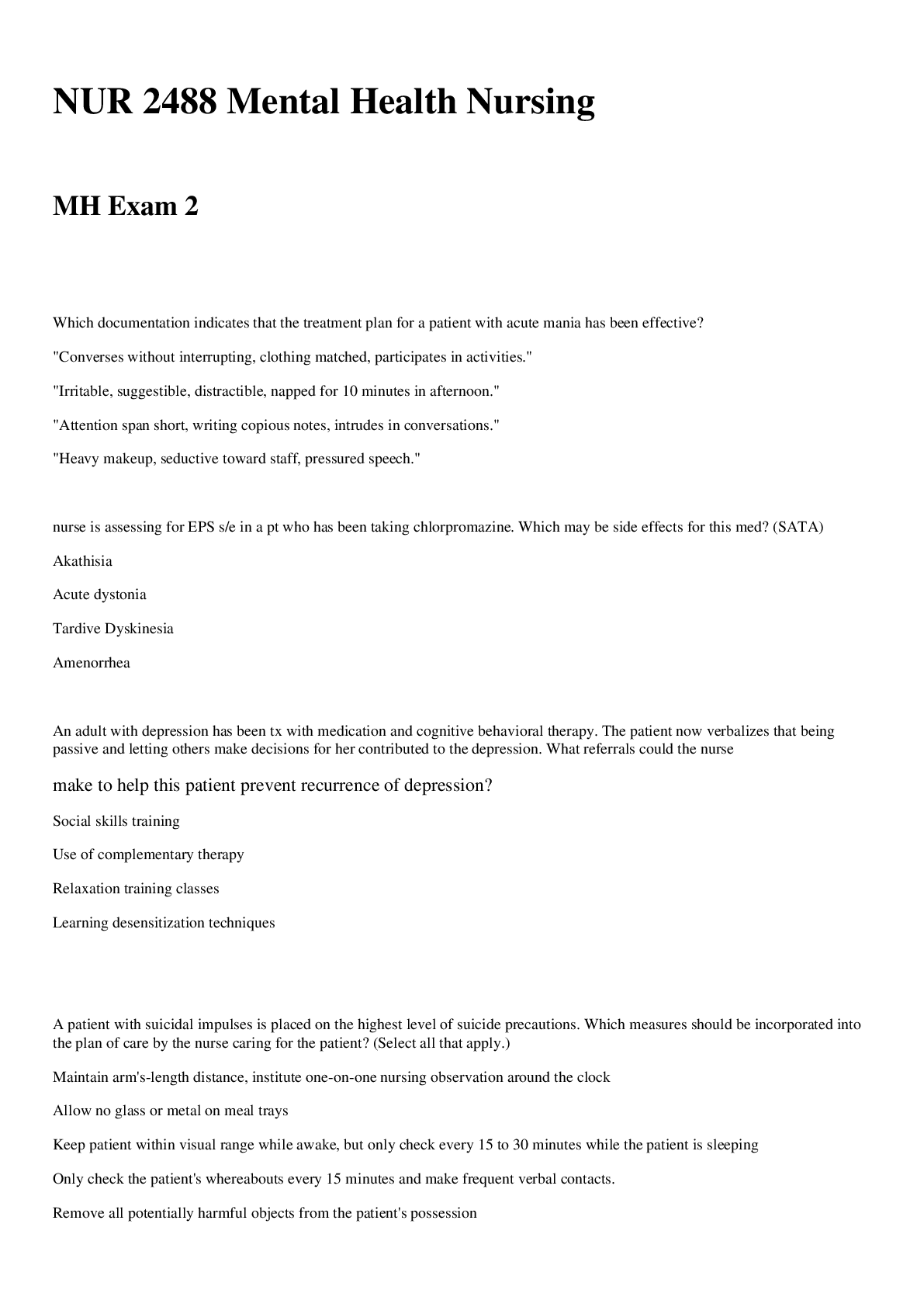
Reviews( 0 )
Document information
Connected school, study & course
About the document
Uploaded On
Nov 14, 2020
Number of pages
11
Written in
Additional information
This document has been written for:
Uploaded
Nov 14, 2020
Downloads
1
Views
168

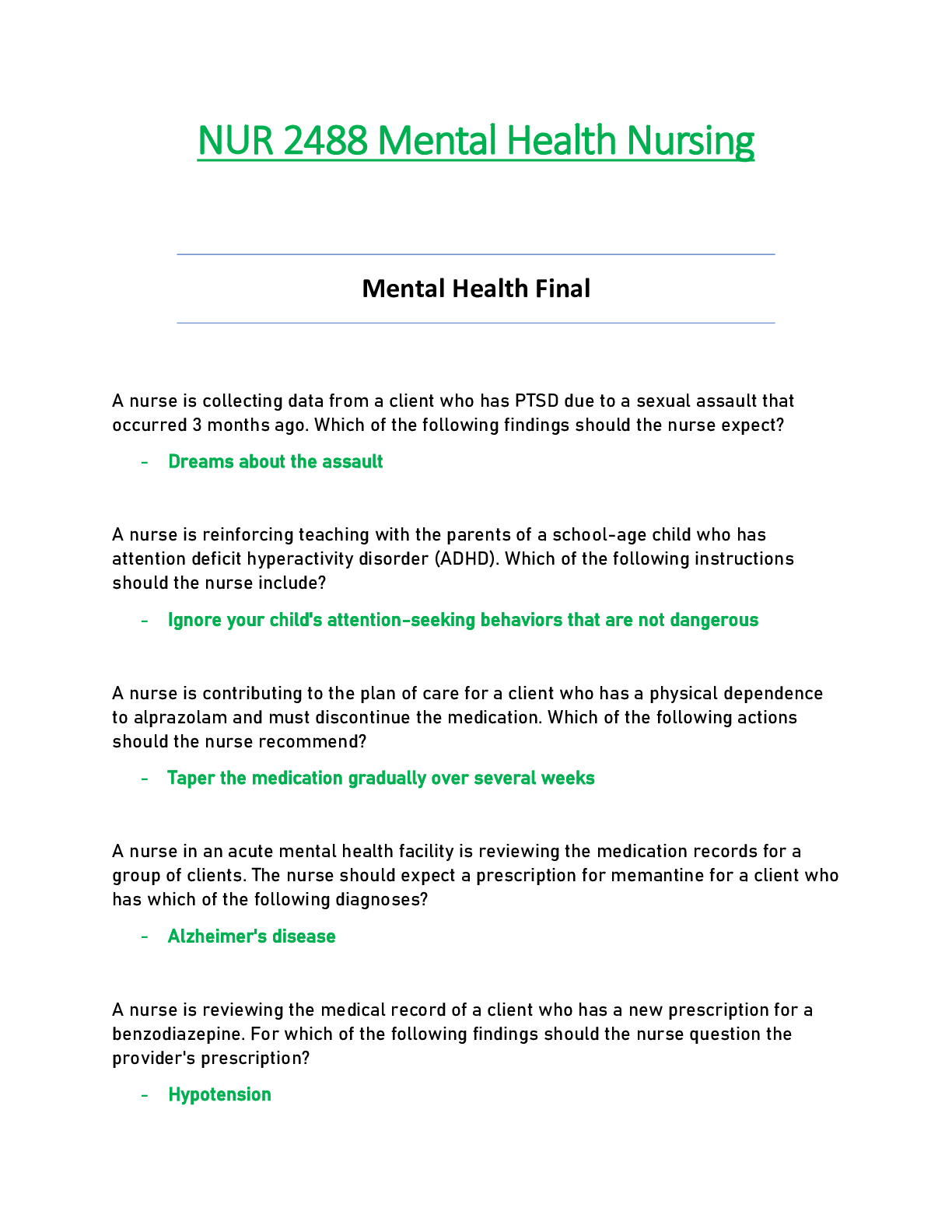
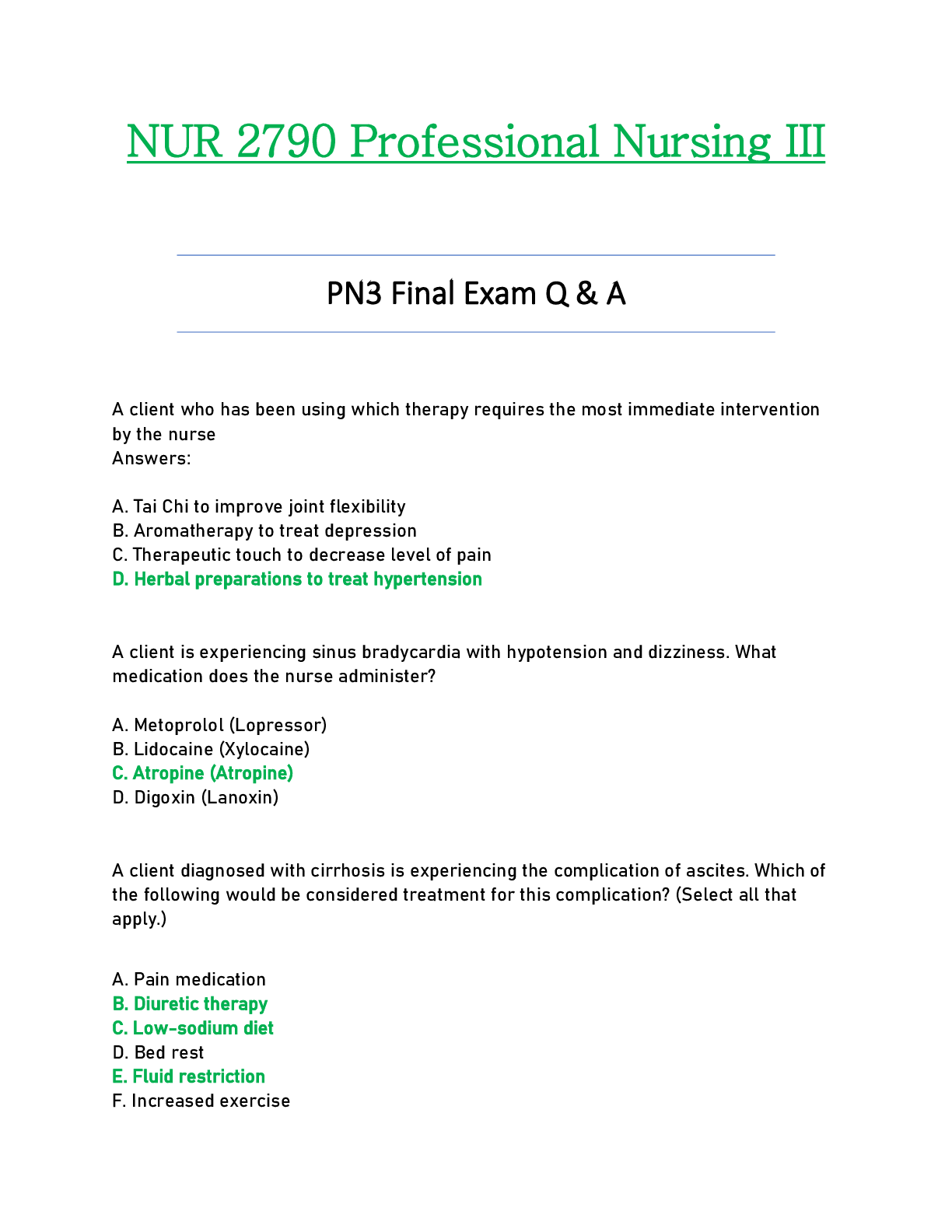
.png)
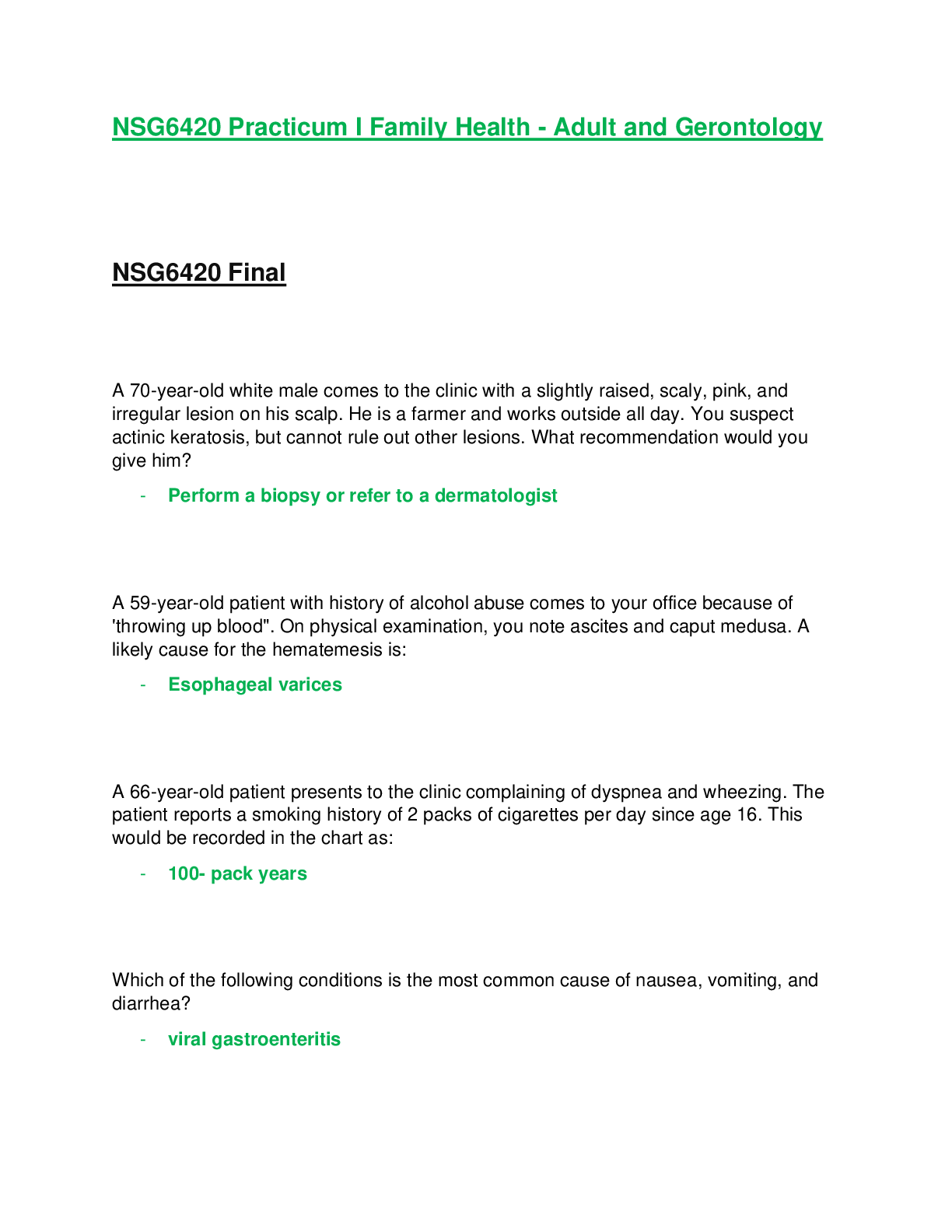
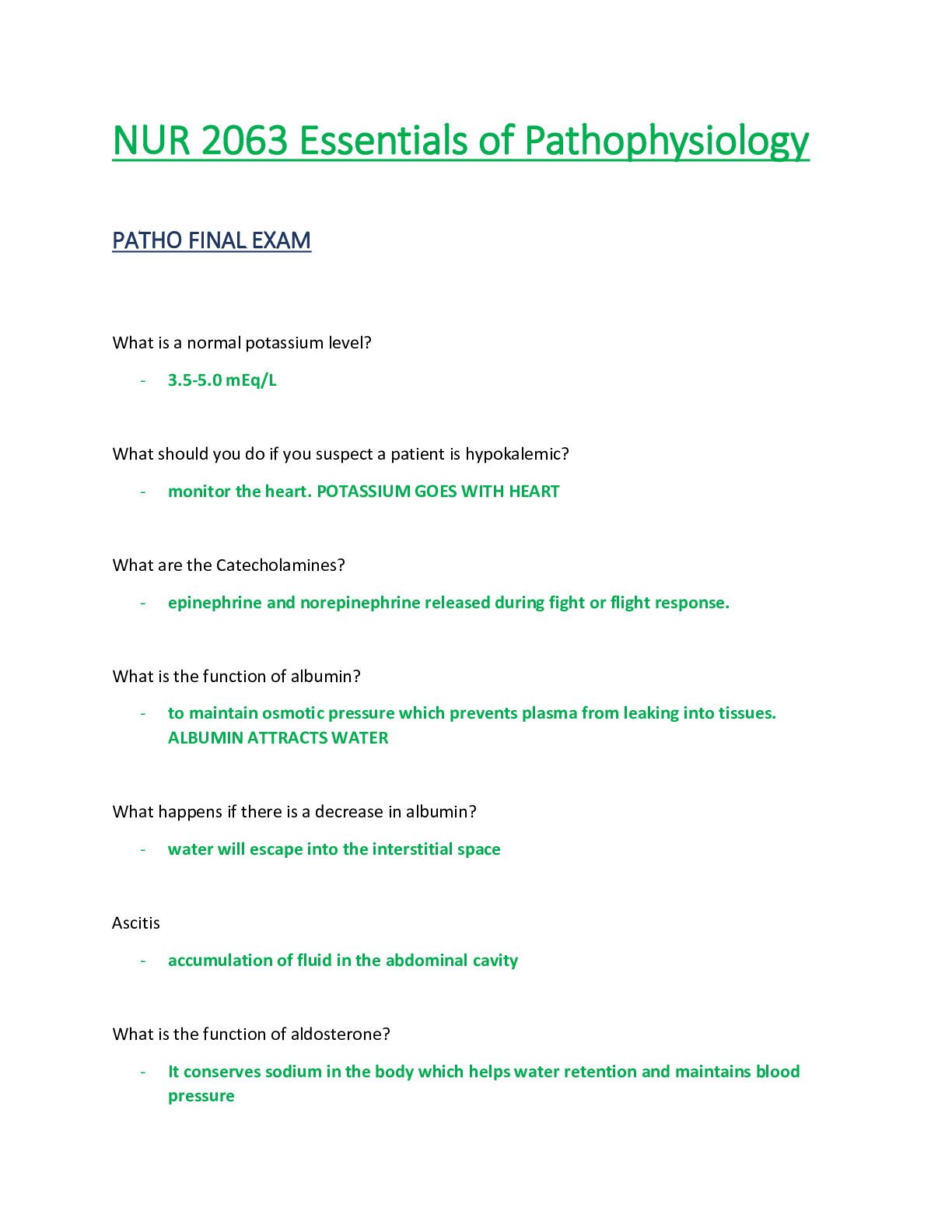

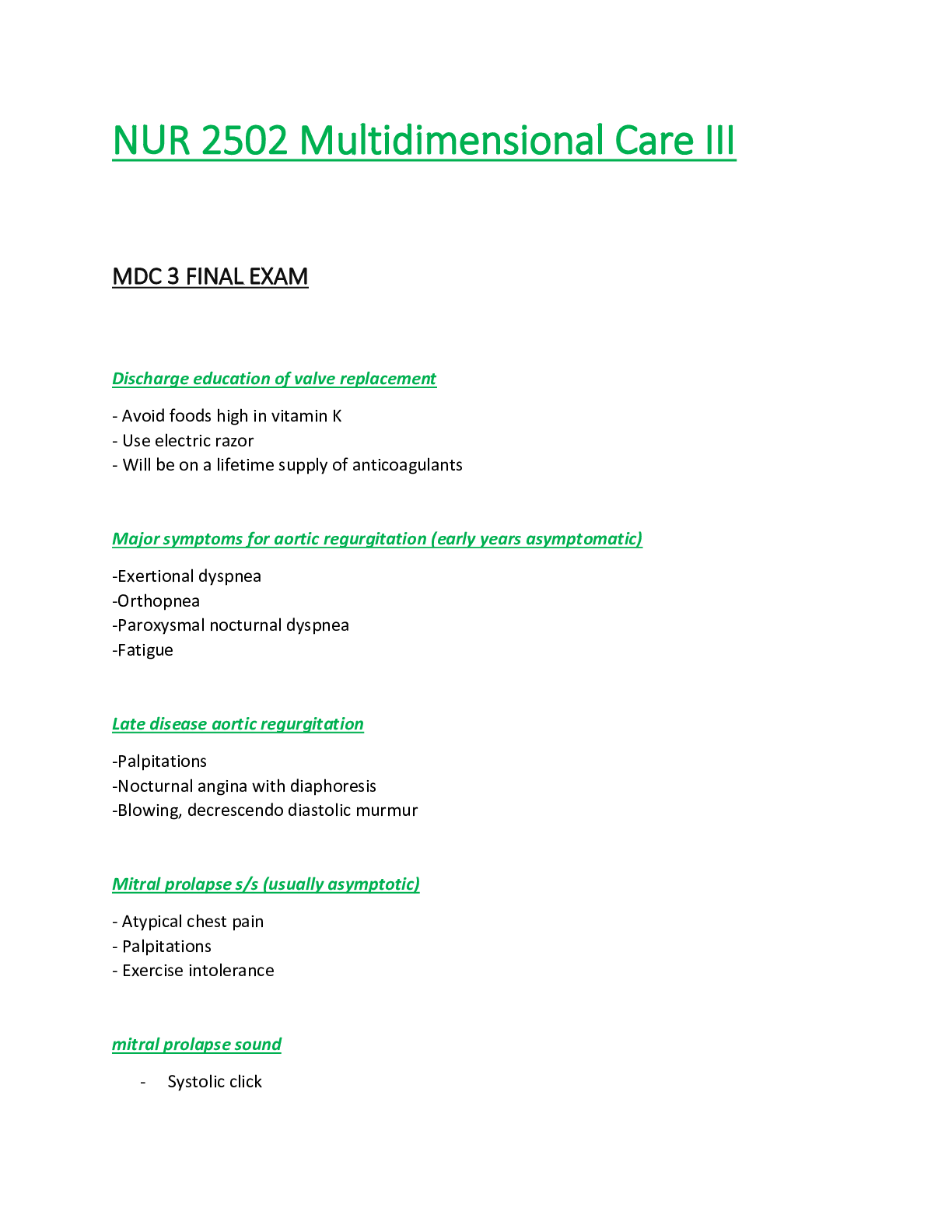
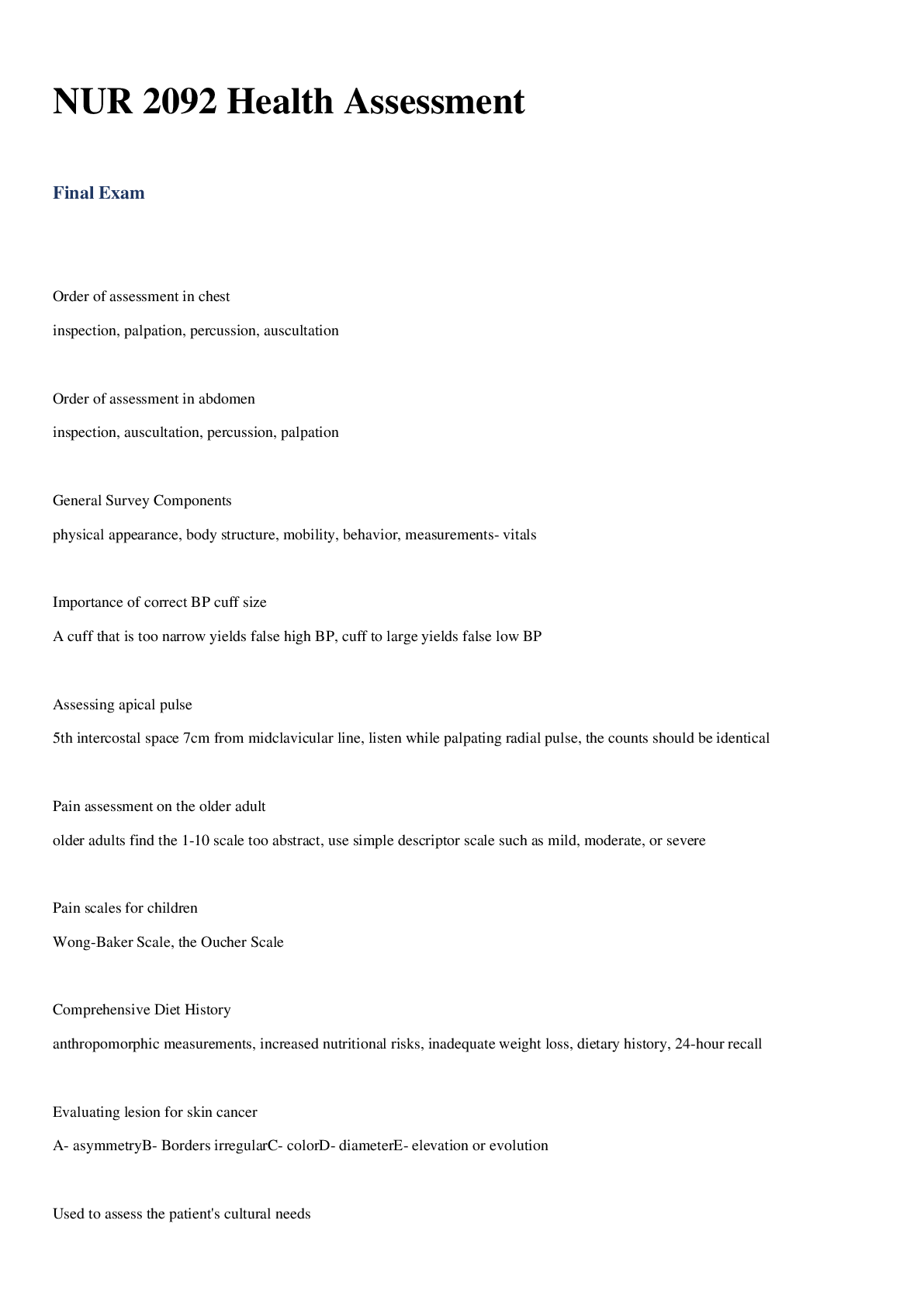
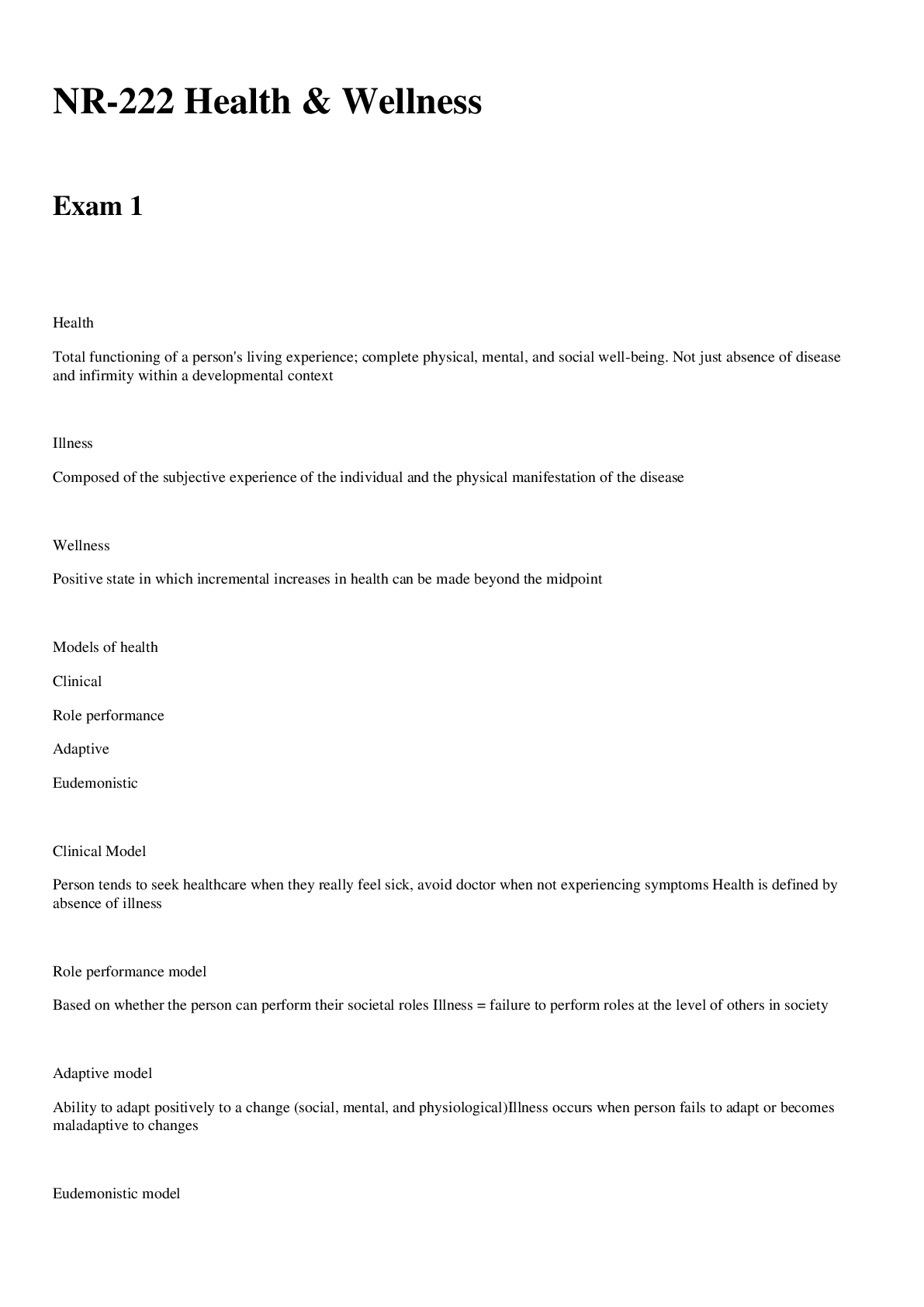
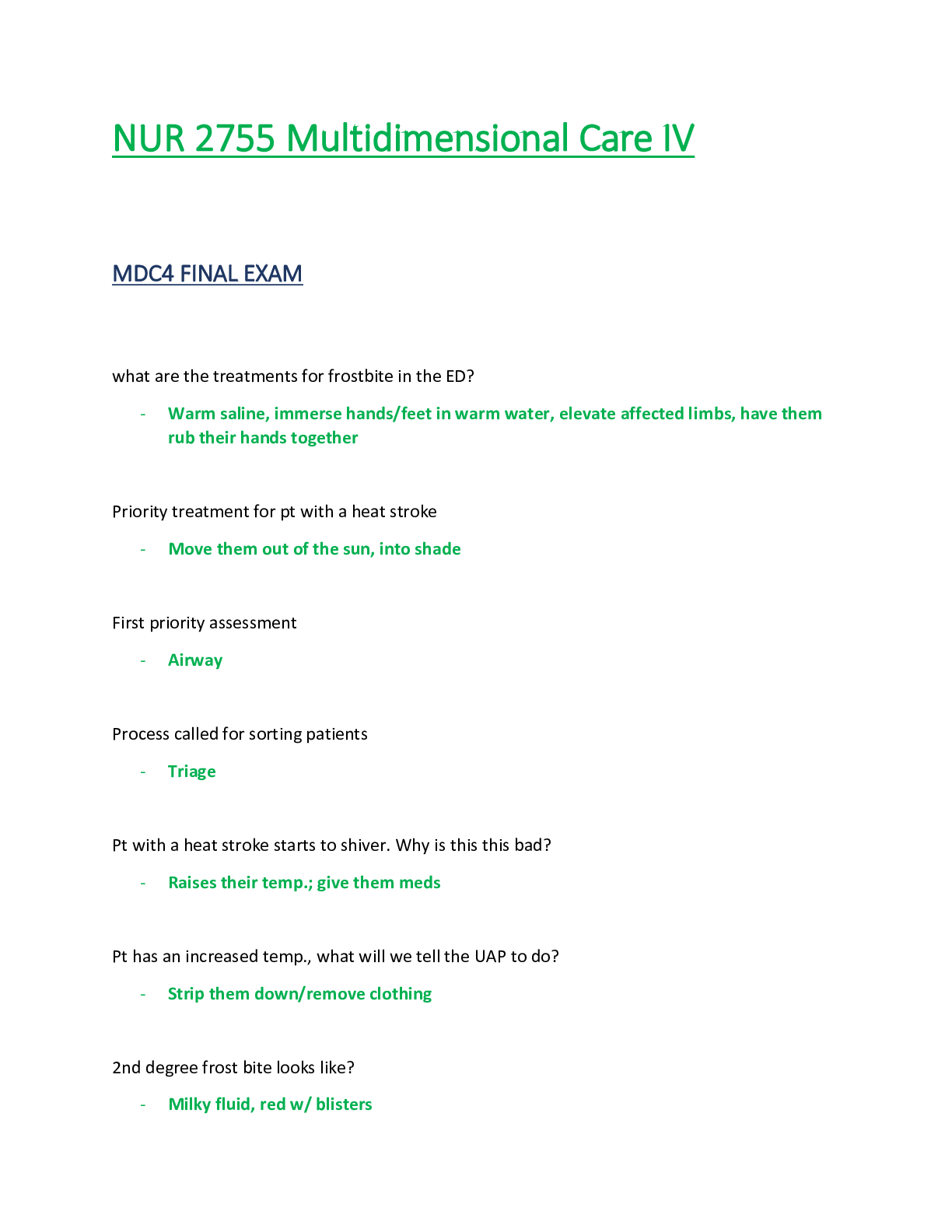
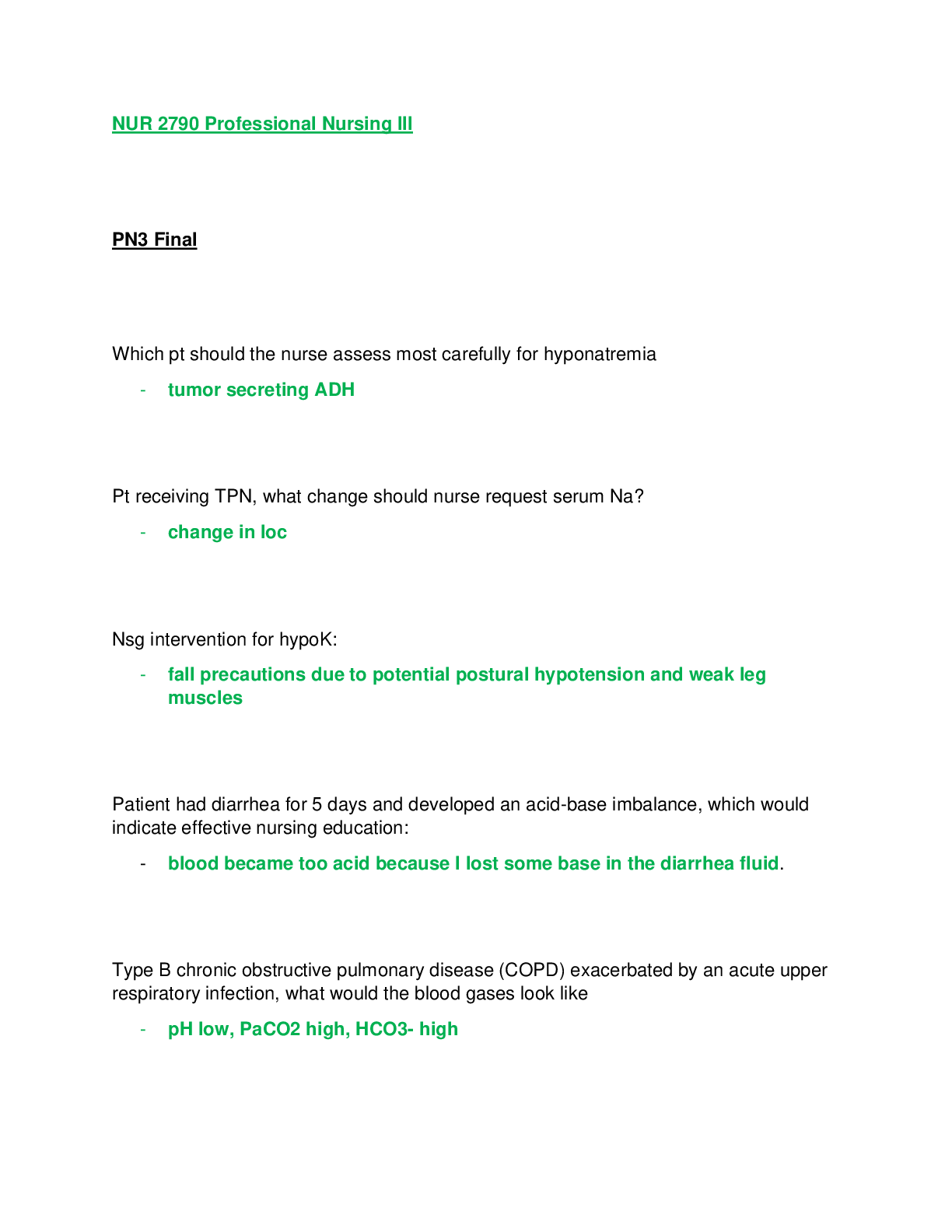
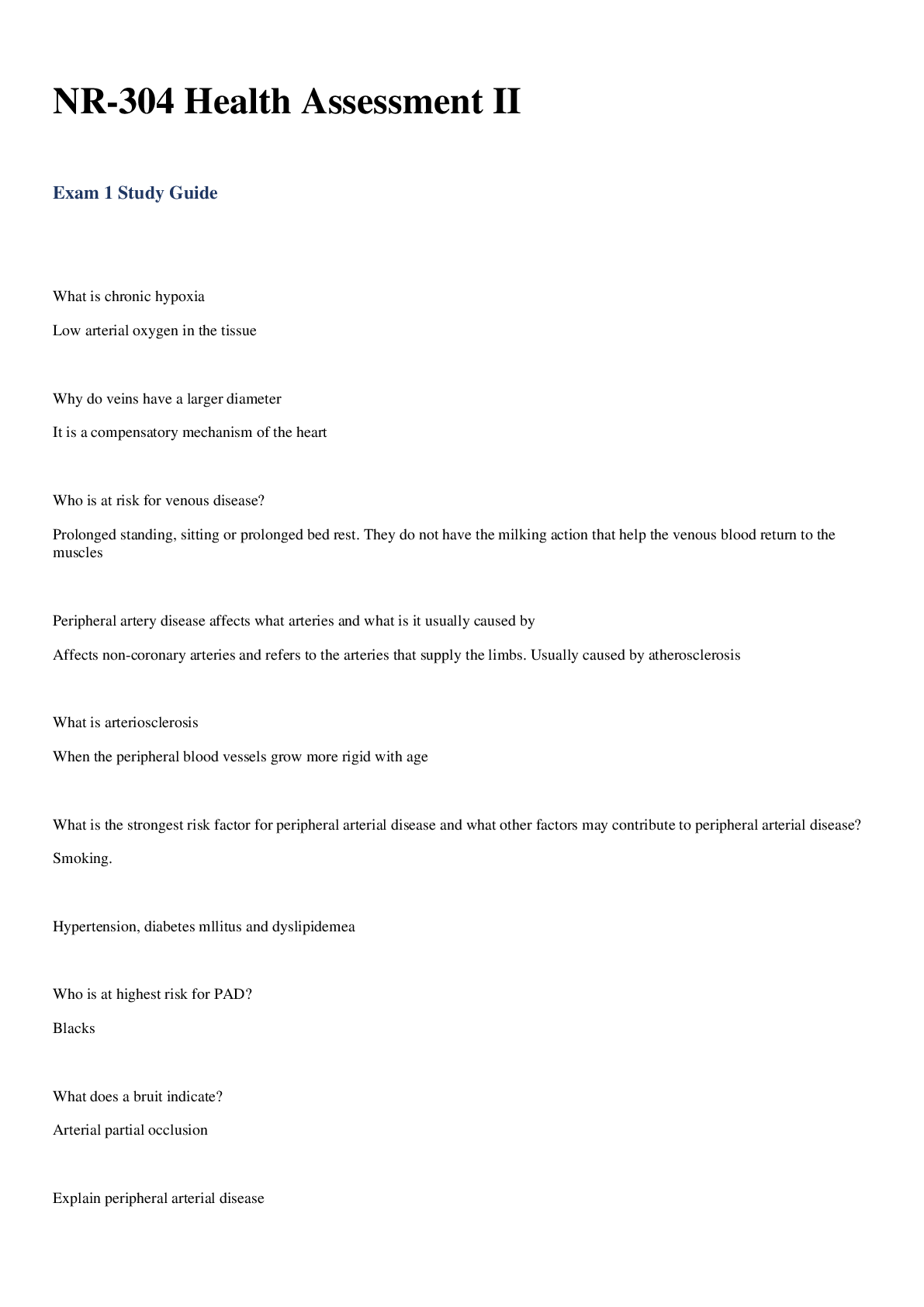

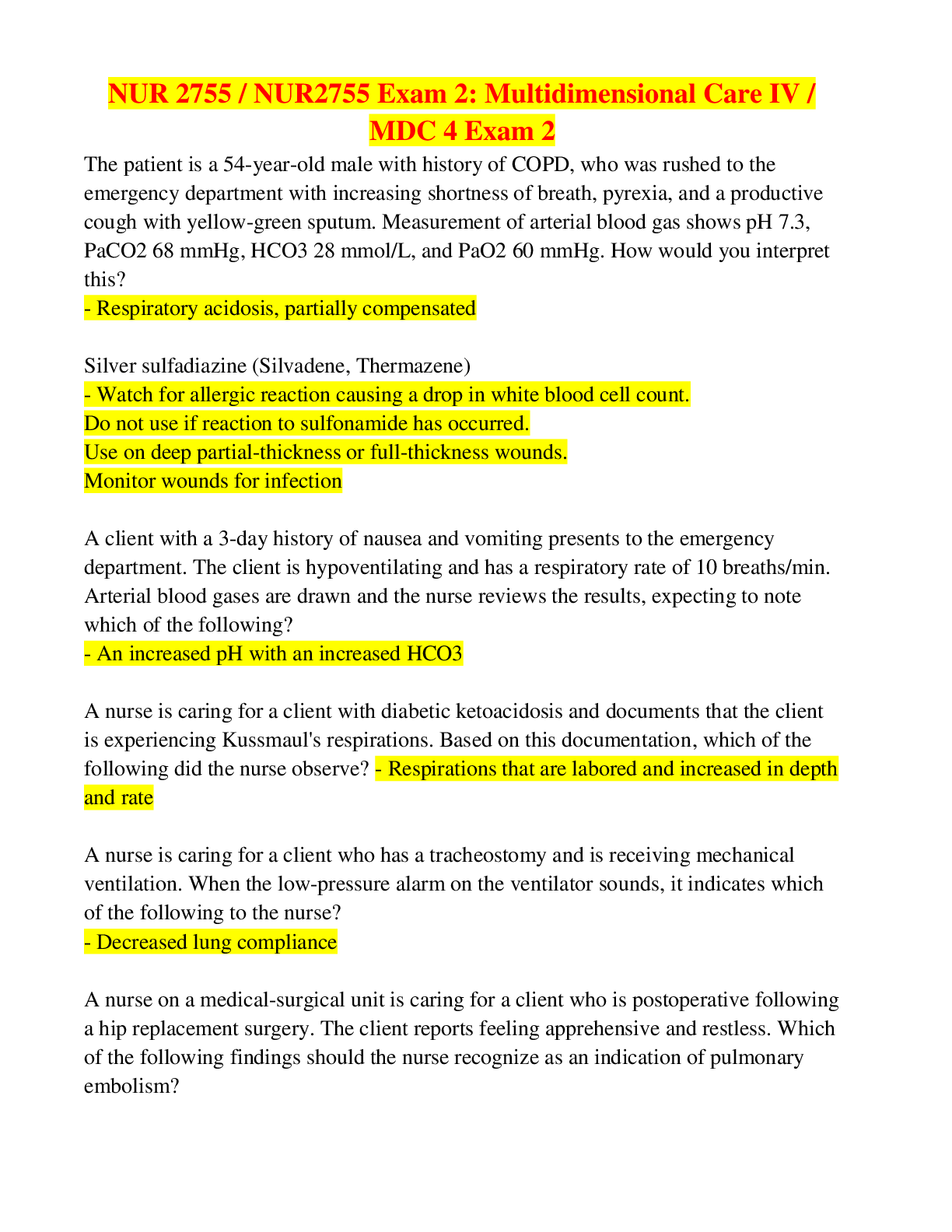
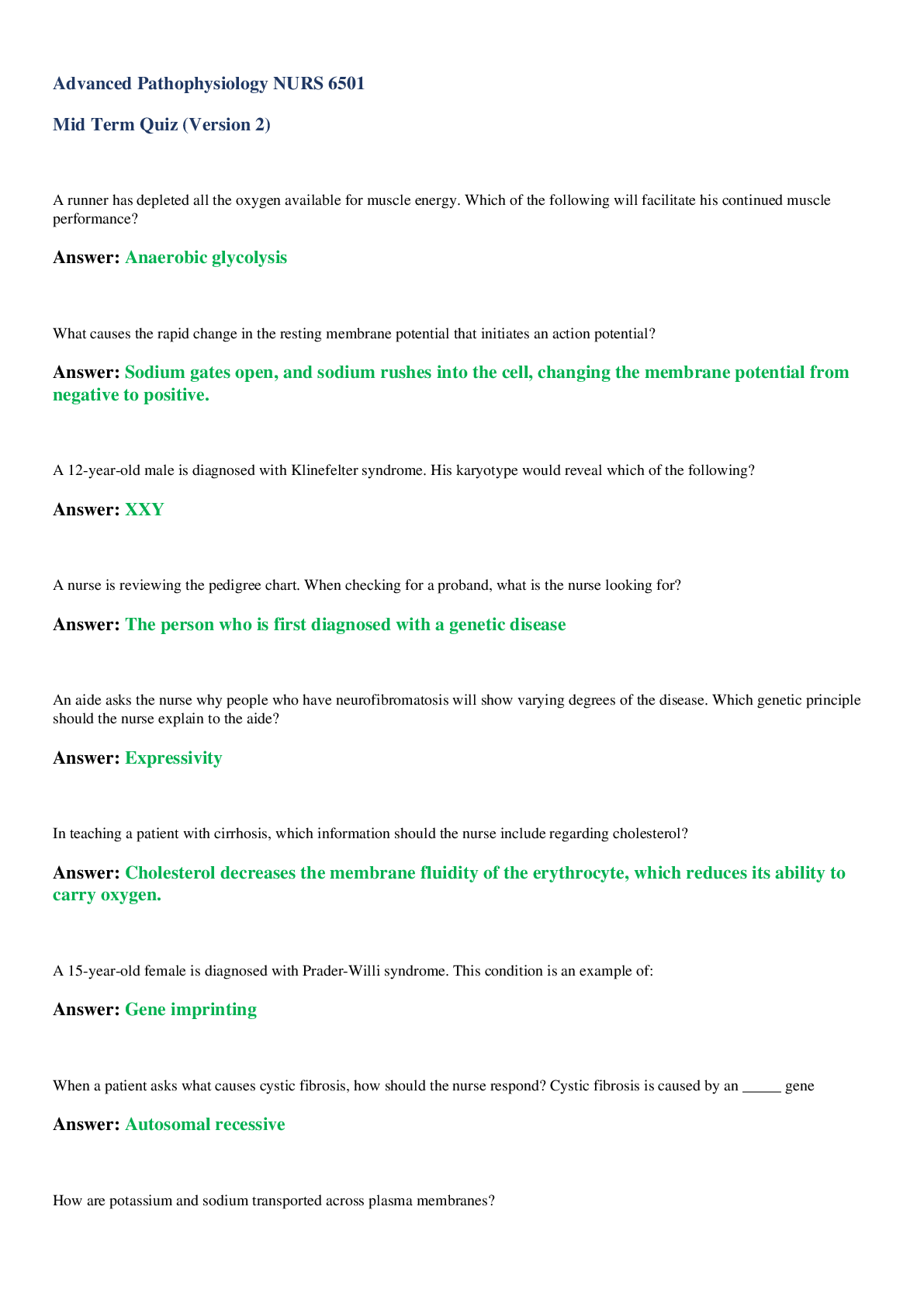
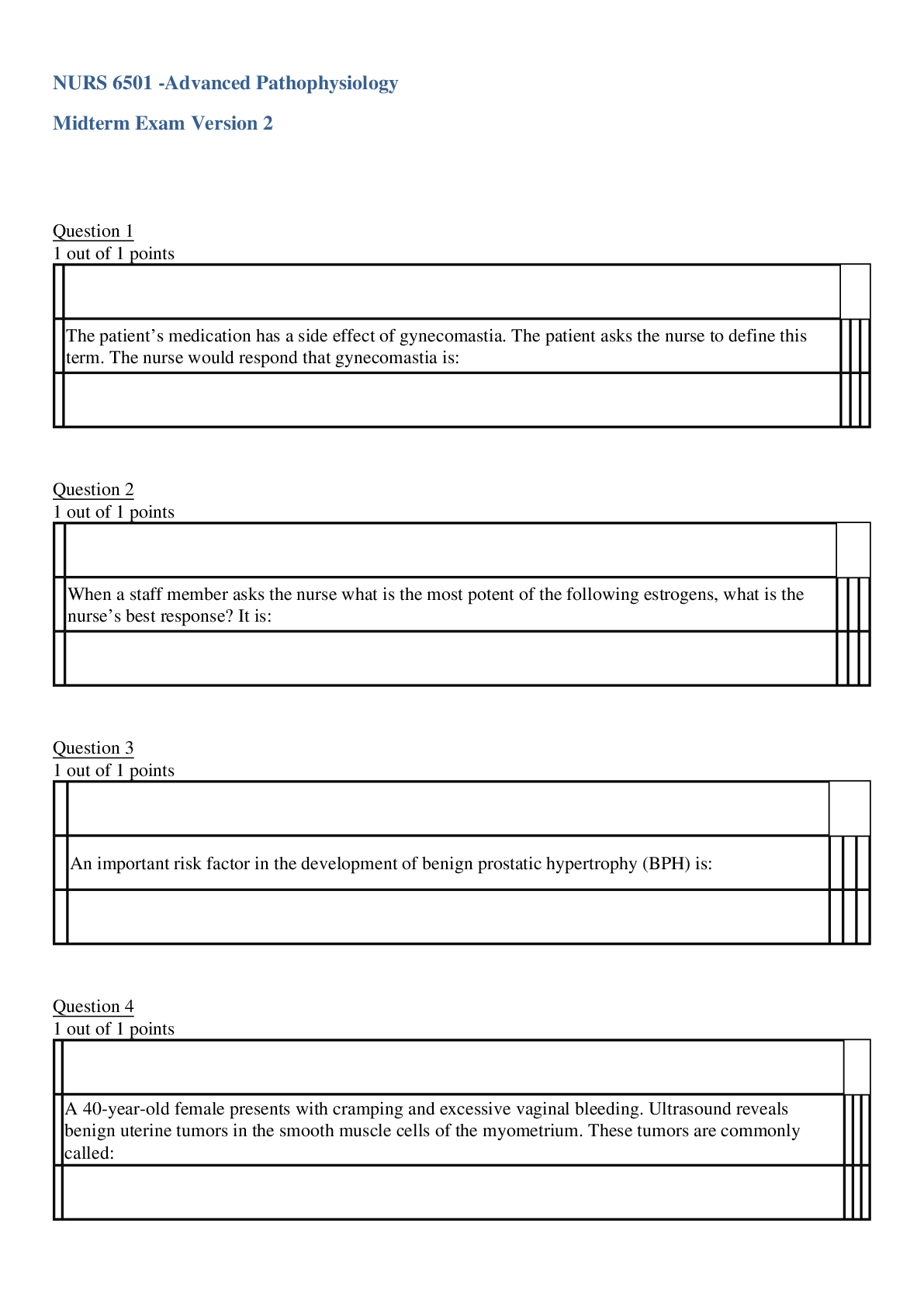
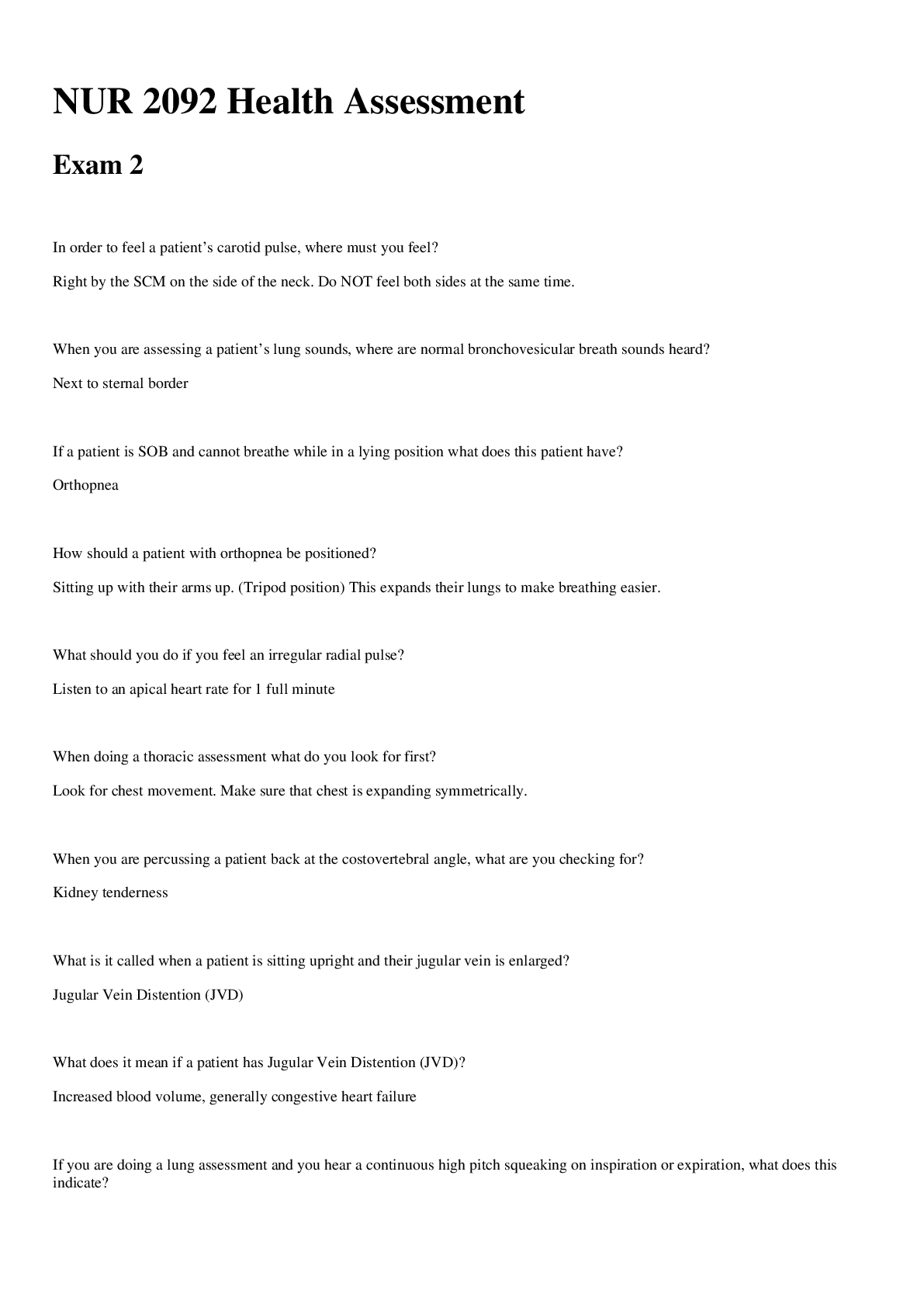
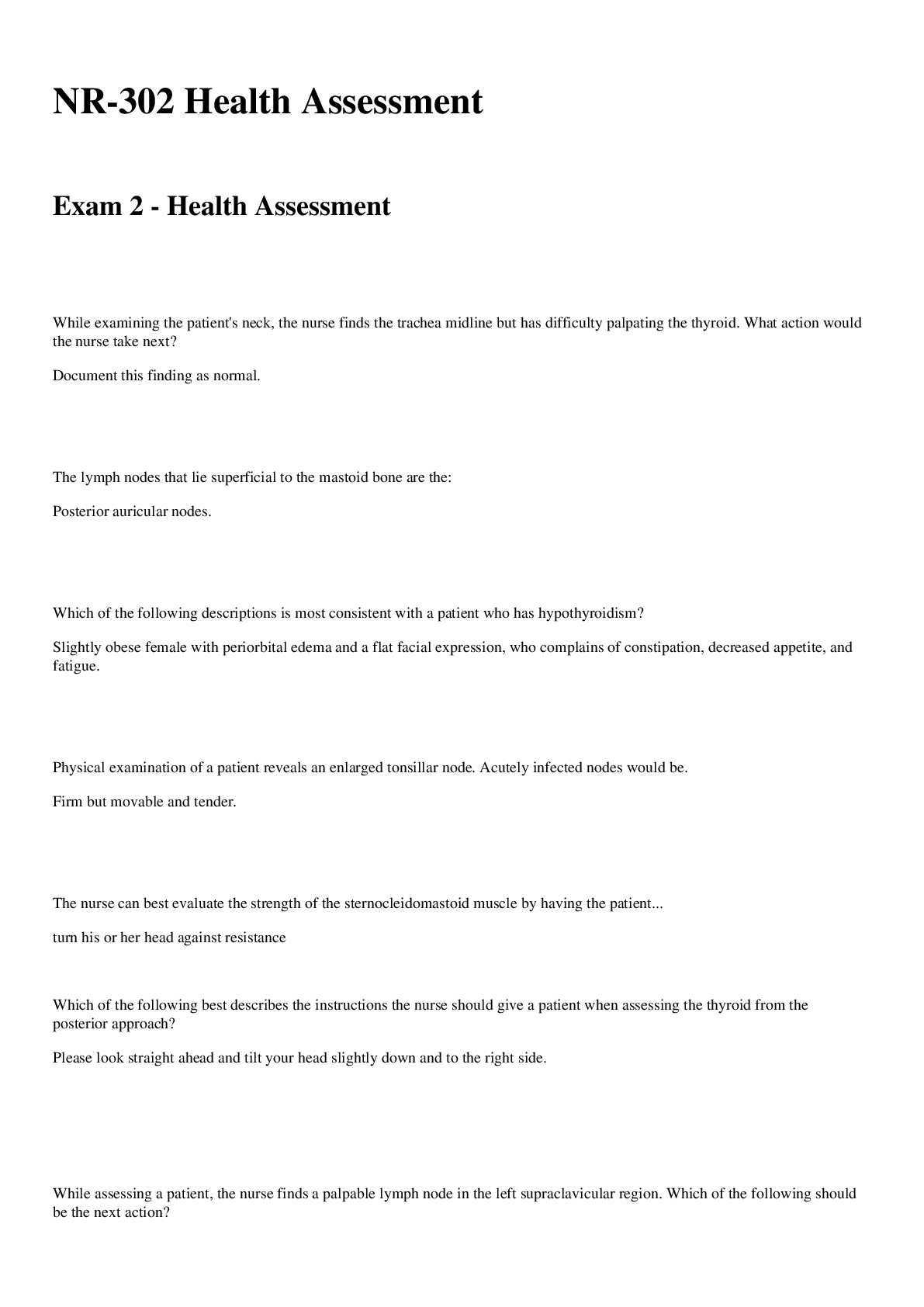
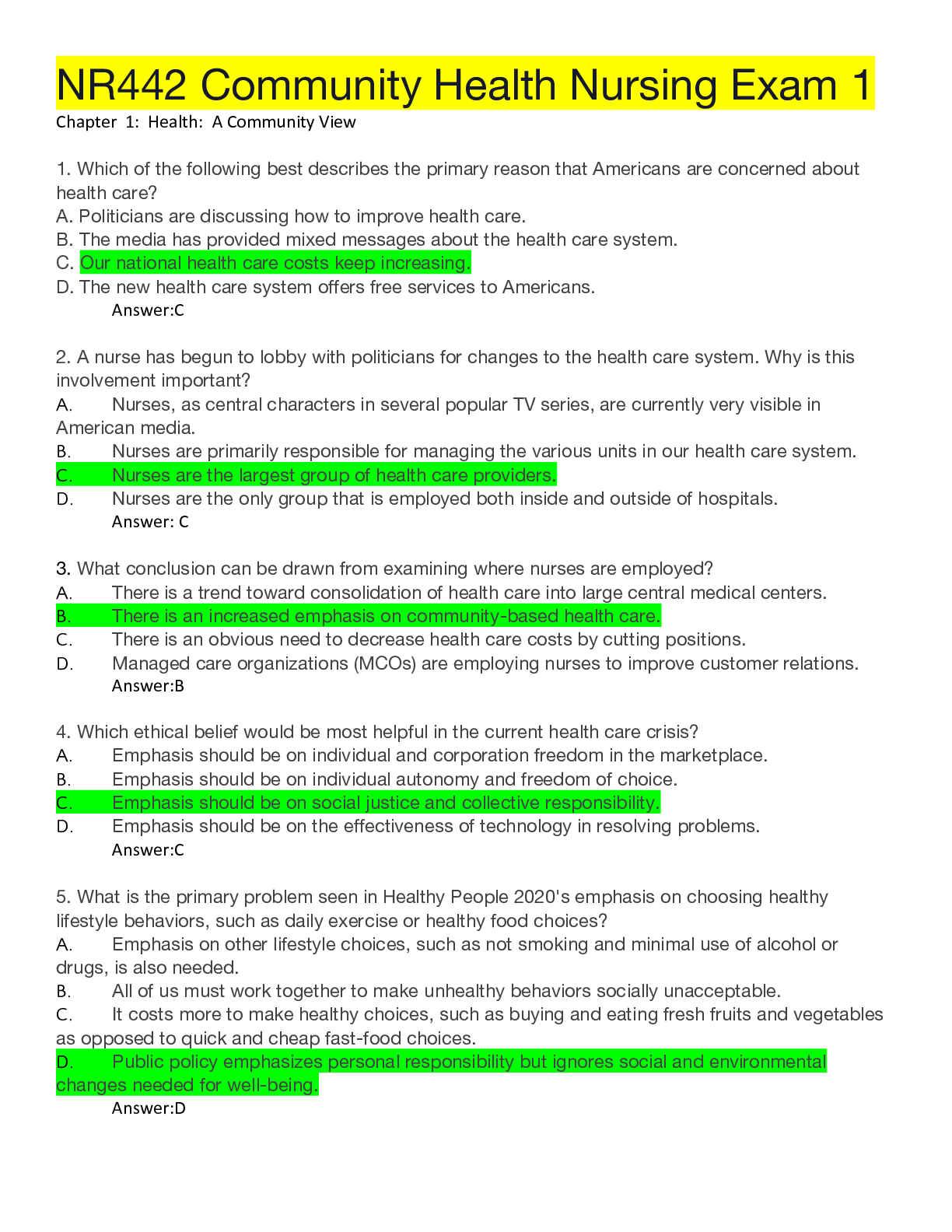
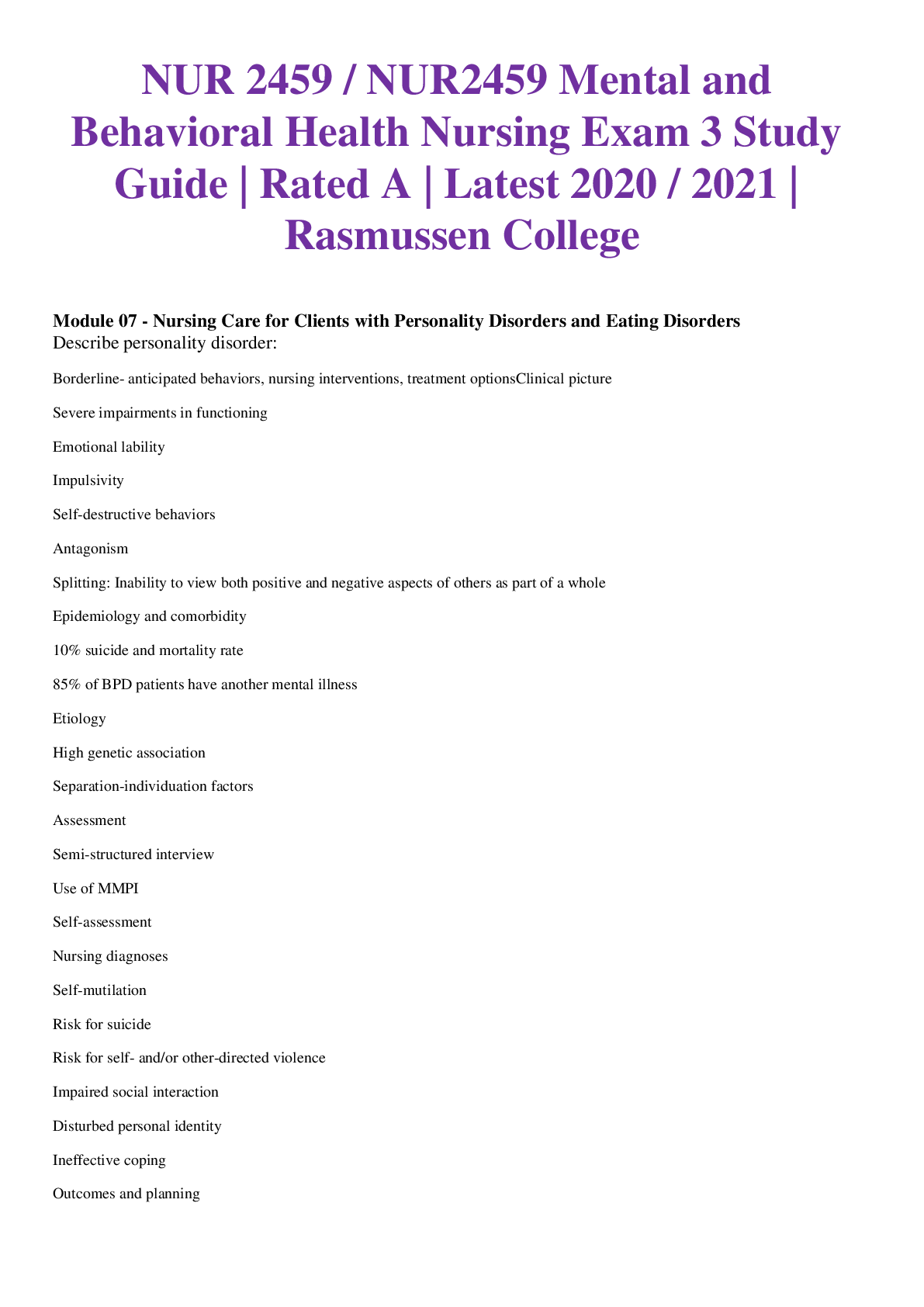

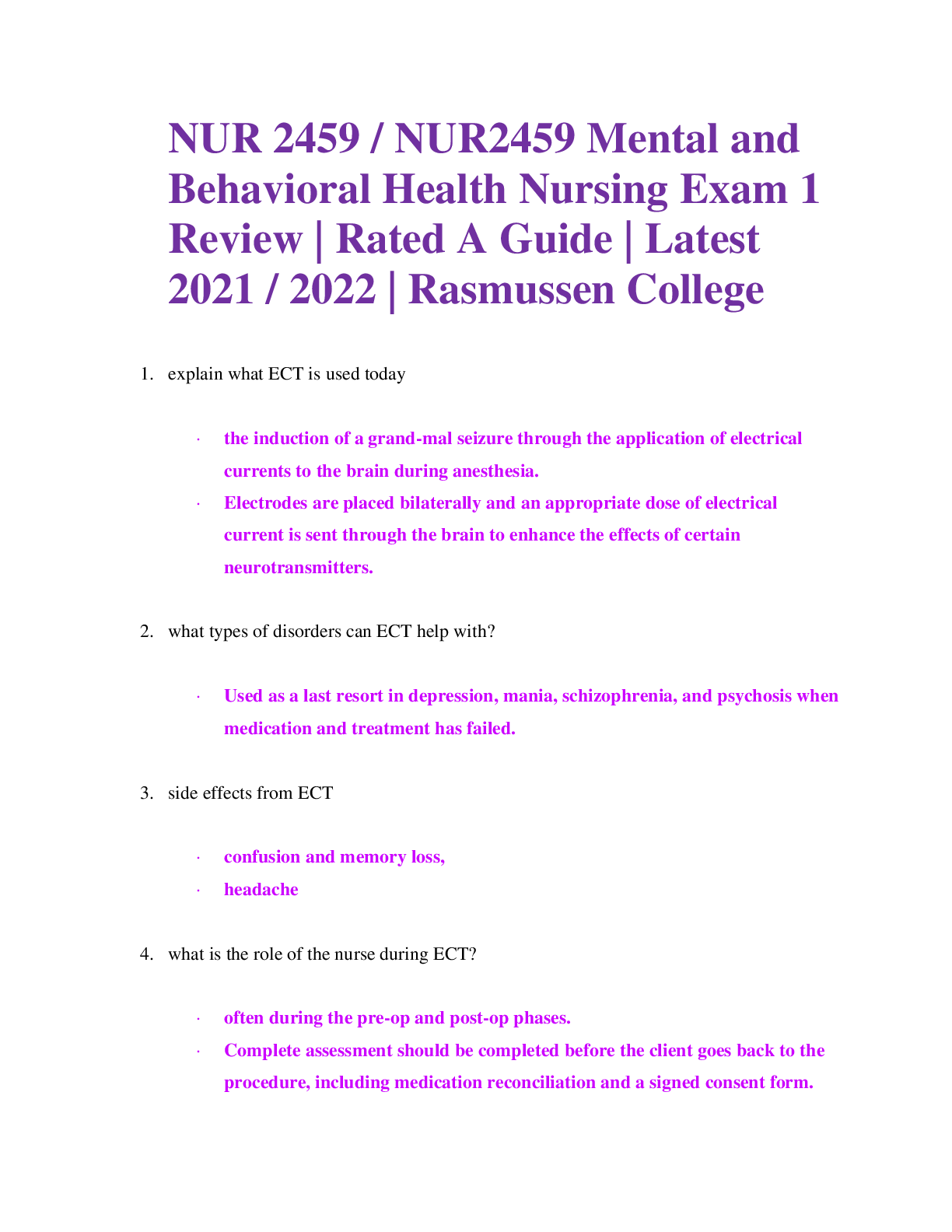
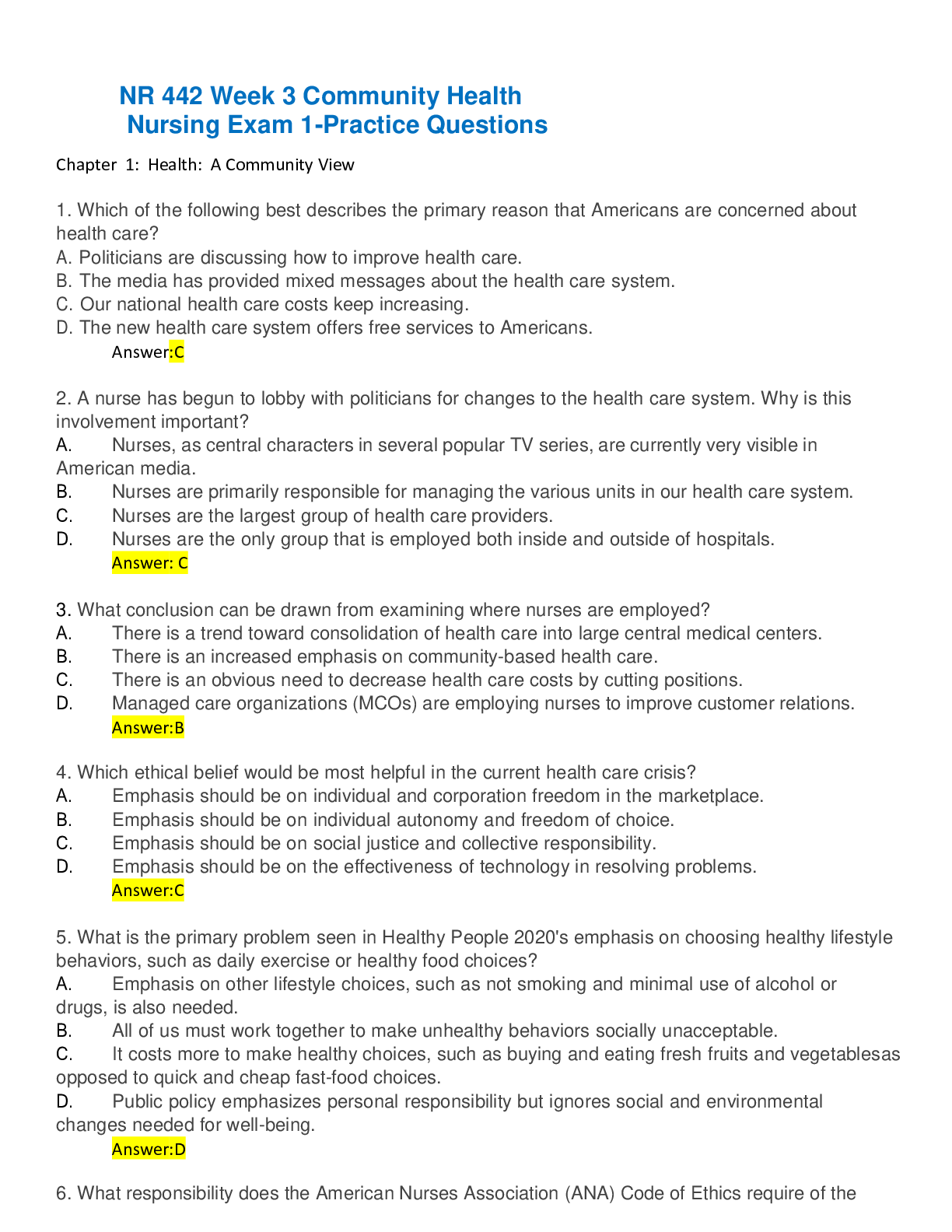
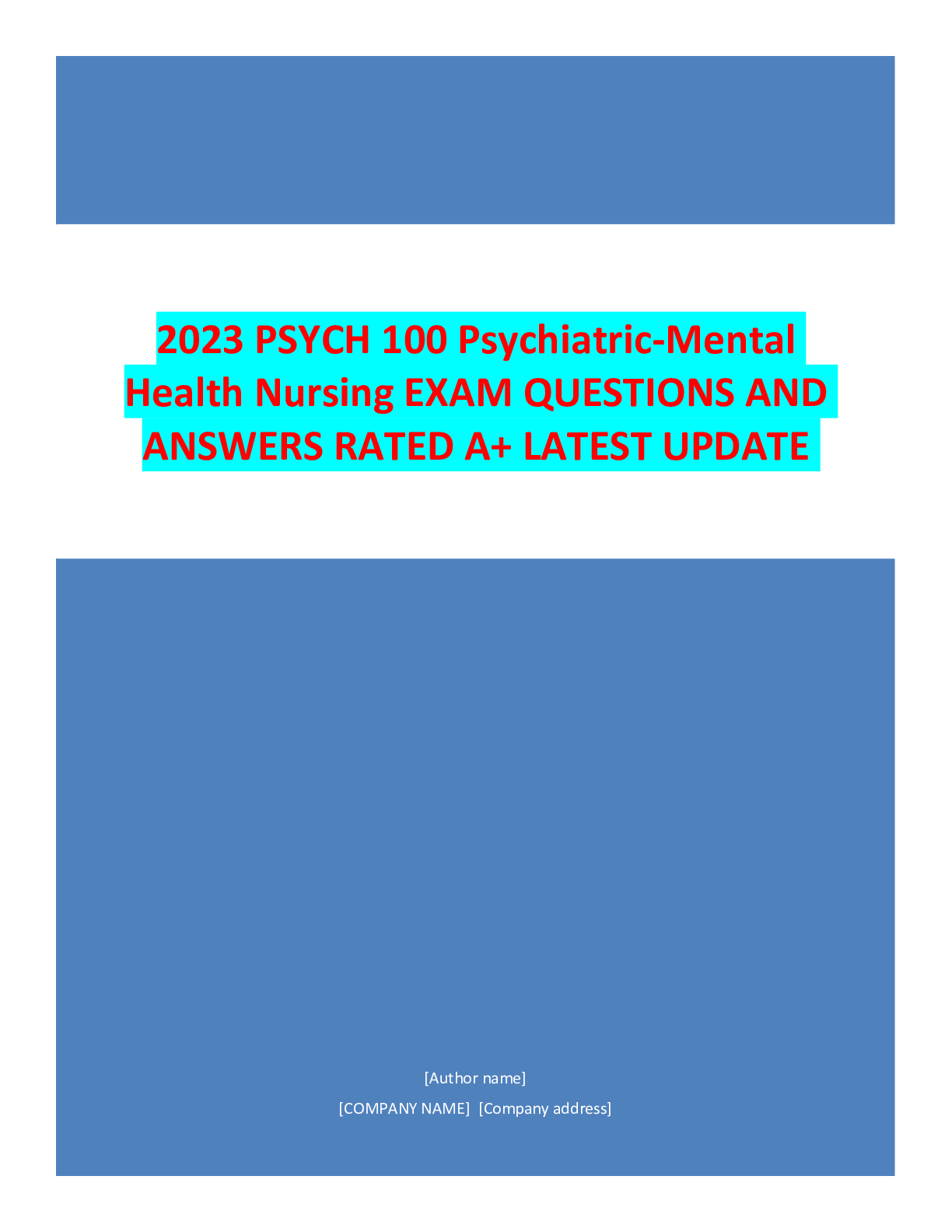
 F21.png)
